Chronic lower back pain can slowly limit your ability to stand, walk, or live comfortably. For people with lumbar spinal stenosis (LSS), the MILD® (Minimally Invasive Lumbar Decompression) procedure has become a life-changing option. It’s minimally invasive, outpatient, and targets the root cause of nerve compression instead of just masking symptoms.
Most patients experience long-term relief lasting five years or more after a single MILD procedure, according to data shared by the Cleveland Clinic and studies published in the Pain Physician Journal (2018). The results often outlast injections and avoid the risks of open spine surgery.
This article explains how long does the MILD procedure last, why it works, how it compares to other options, and what you can expect after treatment.

Understanding the MILD Procedure
The MILD procedure is designed for patients diagnosed with lumbar spinal stenosis (LSS) , a condition where the spinal canal narrows and compresses nerves in the lower back. It’s especially common in adults over 50 due to thickened ligaments, bone overgrowth, or degenerative changes in the spine.
How It Works
During the procedure, a specialist uses a small incision (about the size of a baby aspirin) and advanced imaging guidance to remove small pieces of bone and excess ligament tissue. This opens more space for the spinal nerves without removing the bone structure that supports the spine.
Because it doesn’t involve stitches, implants, or general anesthesia, patients typically return home the same day.
The key advantage of MILD is that it treats the underlying structural problem without major surgery, helping patients walk farther, stand longer, and regain daily independence.
Who It’s Best For
MILD is ideal for people who:
- Have been diagnosed with lumbar spinal stenosis confirmed by MRI or CT scans.
- Experience leg pain or numbness when walking or standing (neurogenic claudication).
- Have not found relief from conservative treatments like physical therapy, medications, or injections.
- Want a minimally invasive option before considering laminectomy or spinal fusion.
In short, MILD fits the “in-between” group, those who need more than pain management but aren’t ready for open surgery.
How Long Does the MILD Procedure Last?
This is one of the first questions most patients ask: How long does the mild procedure last?
The answer depends on your overall spinal health, activity level, and how well you follow post-treatment recommendations. However, multiple clinical studies show MILD offers durable relief that can last five years or longer for most patients.

Clinical Evidence and Longevity
A 2018 multicenter study published in the Pain Physician Journal tracked patients up to five years after undergoing MILD. Over 88% avoided open back surgery, and their improvements in walking distance and pain scores were sustained throughout the follow-up period.
Similarly, the Cleveland Clinic reports that many patients enjoy lasting relief and better mobility without needing additional procedures. Because the thickened ligament doesn’t grow back quickly, the decompression achieved with MILD remains stable for years.
More recent findings from The Spine Journal echo these results, showing that patients maintained significant pain reduction and improved function five years post-procedure. Importantly, no major structural regressions were observed during long-term imaging follow-ups.
For a broader scientific overview, a PRISMA-compliant meta-analysis published in Pain Physician Journal concluded that MILD is both effective and safe for patients with ligamentum flavum hypertrophy, with consistently low complication rates.
Additionally, a long-term review on PMC supports sustained relief and minimal adverse effects for more than two years following MILD, confirming its role as a durable, minimally invasive option.
Why the Results Last
The durability of the MILD procedure comes from its targeted removal of ligamentum flavum, the tissue that thickens and narrows the spinal canal. Once trimmed, there’s significantly less pressure on spinal nerves, and since the bone structure remains intact, there’s little risk of instability.
In contrast, treatments like steroid injections provide only temporary inflammation relief. MILD changes the anatomy permanently, which is why the benefits last so long.
Typical Long-Term Outcomes
Here’s what most patients experience over time:
- 0–6 months: Noticeable pain reduction and increased walking endurance.
- 1 year: Continued improvement in posture and stamina.
- 3–5 years: Stable relief with no return of severe stenosis symptoms.
- 5+ years: Most patients maintain results, though some may need additional therapy if arthritis or other degenerative issues progress.
In many cases, MILD provides a long-term solution that delays or eliminates the need for open decompression surgery.
Comparing MILD to Other Back Pain Treatments
Patients often wonder how MILD stacks up against traditional spine surgeries or non-surgical options like epidural injections. The comparison below highlights major differences in procedure type, recovery, and long-term effectiveness.
Comparison Table: MILD vs. Other Treatments
| Treatment Type | Invasiveness | Typical Recovery Time | Duration of Relief | Key Advantages |
| MILD Procedure | Minimally invasive (tiny incision) | 24–48 hours of rest; normal activity in a few days | Up to 5 years or more | Treats root cause without removing bone; no implants or stitches |
| Epidural Steroid Injections | Non-surgical | Same day | Weeks to 6 months | Fast relief; suitable for mild to moderate pain |
| Traditional Laminectomy | Open surgery under general anesthesia | 6–12 weeks | 10+ years, but higher risk | Removes bone and thickened ligament; effective but more invasive |
This comparison shows that MILD fills the gap between short-term relief and major surgery, giving patients meaningful improvement without long recovery or hospitalization.
When MILD Is the Better Choice
MILD is typically recommended when:
- You’ve already tried injections or physical therapy with limited success.
- MRI results show ligament thickening rather than major bone overgrowth.
- You’re medically unfit or unwilling to undergo open surgery.
By providing sustained decompression with minimal disruption, MILD allows patients to enjoy daily life again without the downtime that traditional surgery requires.
Recovery, Results, and Lifestyle After MILD
After MILD, recovery is straightforward and often surprisingly quick. Most patients resume light activities within a few days and notice improvements in walking and standing within two to six weeks.
The Recovery Timeline
- Day 1–2: Mild soreness at the incision site. Rest and light walking are encouraged to maintain circulation.
- Week 1: Most people reduce or stop pain medications. Some begin gentle stretching or physical therapy.
- Weeks 2–6: Noticeable reduction in leg pain and improved mobility. Patients often report standing longer and walking farther before symptoms return.
- Months 3–6: Maximum benefits are typically achieved. Activities like gardening, errands, and exercise become easier.
Patients can usually return to work and daily routines within a few days, making MILD one of the fastest recoveries among spinal procedures.
Follow-Up Care and Long-Term Maintenance
Maintaining results after MILD is simple but important. Doctors usually recommend:

- Regular follow-up visits: Periodic check-ins help ensure symptoms remain controlled and healing continues as expected.
- Physical therapy: Gentle core strengthening stabilizes the lower back and improves posture.
- Ergonomic adjustments: Using lumbar cushions, supportive shoes, and adjustable seating can minimize strain.
- Healthy habits: A balanced diet, weight management, and daily movement help slow future degeneration.
- Avoiding high-impact stress: Limit repetitive bending or heavy lifting to protect spinal stability.
Most patients find that a few small lifestyle changes extend the benefits of the procedure for years.
What Patients Say
Clinical feedback consistently shows high satisfaction. In one 2022 Pain Practice Journal report, over 85% of patients described MILD as life-changing, citing greater walking distance and fewer pain medications. Many said they regained independence and postponed the need for traditional surgery indefinitely.
These testimonials align with findings from The Spine Journal, where researchers noted that MILD patients maintained improved function up to five years post-treatment.
Is the MILD Procedure Right for You?
Choosing the right treatment depends on your diagnosis, symptom severity, and personal goals. MILD offers a middle-ground solution for people who want something more lasting than injections but less invasive than surgery.
Ideal Candidates
You may be a good candidate if:
- You experience pain, tingling, or numbness in the legs while standing or walking that eases when sitting.
- Imaging confirms hypertrophy (thickening) of the ligamentum flavum, the tissue that compresses spinal nerves.
- You’re seeking a long-term fix without hospitalization or implants.
Doctors typically perform MILD in an outpatient setting under local anesthesia, which means lower risks for older adults or those with other medical conditions. Most procedures take about 60 minutes, and you go home the same day.
How MILD Differs from Temporary Treatments
While epidural steroid injections can ease inflammation, their effect fades in months. Physical therapy helps with flexibility but can’t reverse structural narrowing. Pain medications provide symptom control but do not treat the cause.
MILD corrects the mechanical source of nerve compression, delivering measurable and lasting relief often confirmed through post-procedure imaging showing an expanded spinal canal.
Insurance and Cost Considerations
MILD is FDA-cleared and covered by Medicare and most major insurance plans for qualified patients. Costs vary by location, but since it’s outpatient, total expenses are typically far less than for open spine surgery. Many patients value that it reduces pain, mobility issues, and future healthcare costs.
Atlas Pain Specialists mild® Procedure
If you’re considering the MILD procedure, finding an experienced, board-certified pain management specialist is essential. Atlas Pain Specialists offers the mild® Procedure as part of its advanced treatment program for lumbar spinal stenosis. Their team uses state-of-the-art imaging, personalized evaluation, and minimally invasive techniques to restore spinal space and reduce nerve pressure safely.
The procedure takes less than an hour and requires only a small incision, no general anesthesia, implants, or stitches. Patients typically walk the same day and return to normal activities within days.
For lasting relief, precision care, and proven outcomes, Atlas Pain Specialists provides one of the most trusted approaches to the mild® Procedure. Visit their site to learn more about eligibility, preparation, and recovery guidance tailored to your spinal health needs.
Pain on the inner side of the knee can range from a mild ache after activity to sharp discomfort that limits movement. This area, known as the medial knee region, includes several structures that absorb force, stabilize motion, and bear significant body weight.
When any of these tissues become irritated, injured, or degenerated, even simple movements like climbing stairs or getting out of a chair can cause distress. Persistent discomfort often reflects deeper mechanical or inflammatory problems that deserve careful attention.
Accurate assessment of medial knee pain helps determine whether it stems from joint wear, ligament strain, or inflammation of nearby soft tissues. With precise diagnosis and targeted management, most individuals regain comfort and prevent chronic complications.
Causes Of Pain On Medial Side Of Knee
The medial knee houses ligaments, cartilage, tendons, and bursae that each play a role in stability and load transfer. When one of these components becomes compromised, pain tends to localize sharply along the inner joint line.

| Cause | Description | Typical Triggers or Risk Factors | Pain Characteristics |
| MCL Injury | Stretching or tearing of the inner stabilizing ligament. | Sports impact, sudden twists. | Sharp medial pain, swelling, instability. |
| Meniscus Tear | Damage to inner cartilage cushion. | Deep bending, pivoting under load. | Clicking, catching, pain during rotation. |
| Pes Anserine Bursitis | Inflammation of bursa below joint. | Overuse, tight hamstrings, obesity. | Local tenderness below the joint line. |
| Osteoarthritis | Cartilage thinning in the medial compartment. | Aging, repetitive load, past trauma. | Dull ache, stiffness, morning discomfort. |
| Medial Plica Syndrome | Irritation of inner knee fold. | Repetitive flexion, overuse. | Snapping, mild swelling, intermittent pain. |
Common causes include acute injuries such as ligament sprains and cartilage tears, as well as gradual conditions like osteoarthritis and bursitis. Each presents distinct symptoms and treatment priorities depending on the underlying tissue involved.
- Medial Collateral Ligament (MCL) Injury
The medial collateral ligament stabilizes the inner knee against sideways pressure. Sudden twisting or direct blows during sports frequently strain or tear this ligament.
Pain from an MCL injury appears immediately after the incident and may worsen with sideward motion. Mild sprains often improve with rest, while severe tears sometimes require bracing or rehabilitation guided by a physiotherapist.
A diagnostic examination usually includes the valgus stress test, where outward pressure on the knee reproduces pain if the MCL is compromised. Recovery depends on injury grade, with early protection and progressive strengthening supporting full return to activity.
- Medial Meniscus Tear
The meniscus is a cartilage disc that cushions and stabilizes the knee joint. The medial meniscus endures higher forces than the outer counterpart, making it prone to tears.
Degenerative wear or a sudden twist while bearing weight can cause the cartilage to tear, producing sharp pain and occasional locking. Symptoms often worsen with squatting, pivoting, or prolonged standing.
Diagnosis may involve MRI imaging to confirm the tear pattern and extent. Treatment ranges from physiotherapy and anti-inflammatory measures to arthroscopic repair in cases with mechanical blockage.
- Pes Anserine Bursitis
Below the joint line lies a small fluid-filled sac called the pes anserine bursa. Its purpose is to reduce friction between tendons and the bone during knee movement.
Repetitive stress, obesity, or tight hamstrings can inflame this bursa, leading to localized swelling and pain below the inner knee. Tenderness usually intensifies during stair climbing or side-lying positions at night.
Initial management involves rest, ice application, and targeted stretching to reduce friction on the affected area. If symptoms persist, corticosteroid injections or physiotherapy focusing on muscle balance may be considered.
Key Symptoms and Diagnostic Clues
Medial knee pain can mimic multiple conditions that share overlapping sensations. Differentiating among them relies on precise clinical evaluation and targeted testing.
Doctors assess joint alignment, palpate the tender region, and may perform movement-based tests to reproduce pain. Imaging such as X-rays or MRI clarifies structural changes when physical signs are inconclusive.
Characteristic Pain Patterns
Pain at the inner joint line often reflects cartilage or ligament injury. Sharp localized tenderness indicates mechanical involvement rather than diffuse inflammation.
Patients sometimes report a catching or locking feeling when a meniscus tear interferes with smooth motion. Swelling limited to the inner region commonly suggests bursitis or minor sprain rather than generalized joint fluid buildup.
Associated stiffness after inactivity typically accompanies degenerative processes like osteoarthritis. These observations guide clinicians toward more precise testing before intervention begins.
| Indicator | Possible Cause | Notes |
| Pain on twisting | Meniscus tear | Often produces clicking or locking. |
| Tenderness on inner joint line | Osteoarthritis or meniscus lesion | Worsens after activity. |
| Pain below joint line | Pes anserine bursitis | Increases with climbing or kneeling. |
| Valgus stress reproduces pain | MCL injury | Confirms ligament instability. |
| Stiffness easing with motion | Osteoarthritis | Indicates chronic cartilage wear. |
Relief and Treatment
Effective treatment depends on cause, severity, and the patient’s activity level. Most cases improve with non-surgical interventions emphasizing rest, strength, and controlled movement.
Doctors often begin with conservative management before considering injections or surgery. The goal is to relieve discomfort while preserving long-term knee function.
- Home and Conservative Care
Initial relief often involves the RICE protocol: rest, ice, compression, and elevation. These measures reduce inflammation and limit swelling in the early stages.
Supportive braces may stabilize the knee and prevent excessive side movement during recovery. Over-the-counter anti-inflammatory medication can help ease pain in mild injuries.
Consider:
- Limiting activities that cause twisting or sideward strain.
- Applying ice for 15–20 minutes several times daily.
- Using a soft brace if recommended by a professional.
- Avoiding prolonged immobilization to prevent stiffness.
- Physical Therapy and Exercise
Therapeutic programs aim to restore strength, flexibility, and joint alignment. Exercises typically focus on quadriceps, hamstrings, and hip stability.
A physiotherapist tailors routines to avoid aggravating sensitive areas. Gradual load progression ensures tissue adaptation without overstrain.
Popular exercises include wall sits, hamstring curls, and step-ups under professional supervision. Balance training also enhances proprioception, lowering reinjury risk once normal activity resumes.
- Medical and Surgical Interventions
When conservative care fails, physicians may recommend targeted injections or minimally invasive surgery. These options are reserved for persistent or structural causes of pain.
| Approach | Purpose | Examples |
| Rest and Load Control | Reduces stress on healing tissue. | Short rest followed by gradual activity. |
| Ice and Compression | Limits inflammation. | 15–20 minutes several times per day. |
| Physical Therapy | Restores motion and strength. | Muscle balancing, flexibility work. |
| Bracing or Taping | Improves stability. | Hinged braces for MCL support. |
| Medication | Eases pain and swelling. | NSAIDs, topical gels. |
| Injections | Reduces chronic inflammation. | Corticosteroid or hyaluronic acid. |
| Surgery | Repairs structural damage. | Meniscus repair or realignment. |
Corticosteroid injections can temporarily reduce inflammation in bursitis or arthritis. Hyaluronic acid may improve joint lubrication and mobility in degenerative cases.
Surgical repair or removal of torn meniscus fragments is considered when locking or mechanical instability interferes with daily function. Early rehabilitation after surgery preserves joint motion and strength.
How to Prevent Future Knee Pain
Preventing medial knee pain involves maintaining strength, flexibility, and proper movement mechanics. These measures reduce repetitive strain on vulnerable inner structures.
Lifestyle choices like balanced exercise routines and joint-friendly footwear contribute significantly to protection. Consistency in care yields lasting comfort and mobility.

- Strength and Conditioning
Strong muscles support and offload stress from the knee joint. Balanced training of quadriceps, hamstrings, and hip abductors provides symmetrical control.
Low-impact activities such as cycling, swimming, and brisk walking build endurance without overloading the joint. Avoiding sudden intensity spikes helps prevent recurrent microtrauma.
Regular assessment of movement form ensures alignment during both exercise and daily tasks. Even minor posture corrections can meaningfully reduce medial strain.
- Flexibility and Weight Control
Tight muscles alter knee mechanics and contribute to bursitis or ligament tension. Stretching of hamstrings, calves, and quadriceps enhances range of motion.
Weight management lowers compressive forces that accelerate cartilage wear. A moderate calorie intake with nutrient-rich food supports overall joint health.
Professional guidance from a physiotherapist or trainer ensures proper technique and progress monitoring. Sustainable habits outperform occasional corrective efforts.
- Protective Equipment and Technique
Athletes and workers benefit from using knee supports when engaging in repetitive or high-impact tasks. Proper footwear with supportive midsoles maintains leg alignment.
Avoiding deep squats or twisting under heavy load prevents strain on ligaments and cartilage. Gradual warm-up routines prepare soft tissues for movement.
Remember:
- Warm up before intense activity.
- Replace worn footwear regularly.
- Maintain even leg strength and posture awareness.
When to Seek Medical Evaluation
Ongoing pain on the inner side of the knee should not be dismissed as a simple strain or temporary soreness. Medical evaluation helps identify tissue injury, inflammation, or early degeneration before these issues worsen.
Even mild symptoms can mask damage to ligaments, cartilage, or the joint lining. Timely consultation with a healthcare provider ensures that the underlying cause receives appropriate and precise treatment.
- Identify Signs Early
Certain symptoms indicate a need for immediate medical attention. Sudden swelling, bruising, or a sensation of tearing often points to meniscus or ligament injury.
A popping sound during motion or loss of stability suggests structural disruption inside the joint. Difficulty bearing weight or locking during flexion may signal mechanical obstruction from loose fragments or displaced tissue.
Redness, warmth, or fever around the knee can imply infection or inflammatory disease. In these cases, prompt diagnosis prevents joint damage and reduces the risk of long-term complications.
- When Chronic Pain Persists
Pain that lasts longer than two weeks or worsens with activity can indicate degenerative or inflammatory processes. Osteoarthritis, tendinopathy, and synovial irritation commonly present with dull, recurring discomfort.
Morning stiffness, grinding sensations, or clicking sounds often accompany cartilage thinning or irregular joint surfaces. Without timely management, these mechanical changes may limit range of motion and increase fatigue during walking or climbing.
Recurrent swelling after moderate exertion suggests underlying joint instability or poor alignment. Continuous irritation in the same region warrants orthopedic review for targeted treatment and corrective exercises.
- Diagnostic Steps and Professional Assessment
Physicians begin by evaluating movement patterns, palpating the joint, and testing flexibility. These manual assessments provide essential clues about which structures contribute to pain.
Imaging tests like X-rays, ultrasound, or MRI reveal the extent of tissue injury or degeneration. MRI scans are especially useful for detecting meniscal tears, cartilage wear, and inflammation around tendons or ligaments.
Blood tests may accompany imaging if infection or systemic inflammation is suspected. Identifying biochemical markers helps guide medication and rehabilitation decisions.
Benefits of Early Medical Intervention
Prompt evaluation enables precise diagnosis and prevents mild symptoms from escalating into chronic conditions. Early treatment often limits inflammation and protects surrounding tissues from overcompensation strain.
Professional care helps establish structured recovery through physical therapy and supervised exercise. This approach reduces pain while restoring coordination, flexibility, and confidence in movement.
Ignoring early warning signs can extend recovery time and increase the likelihood of reinjury. Seeking timely medical input keeps the healing process efficient and minimizes long-term joint stress.
Hurts to Straighten Knee? Here's What You Need To Know
Experiencing inner knee pain shows how balance, alignment, and tissue resilience determine overall joint comfort. Careful evaluation and early treatment can restore smooth motion and prevent recurring discomfort.
As pain subsides, attention to movement quality and muscular stability becomes essential for long-term relief. Consistent rehabilitation and joint-friendly activity preserve strength while protecting the inner structures of the knee.
Effective recovery depends on sustained awareness of daily movement habits and posture. When managed thoughtfully, the knee regains stability, allowing confidence in movement without lingering pain.
Thoracic Outlet Syndrome (TOS) can be both frustrating and confusing. It often starts subtly, a tingling in the fingers, a dull ache in the shoulder, or numbness down the arm, and is frequently mistaken for more common issues like carpal tunnel syndrome or a pinched nerve in the neck.
The truth is, TOS is caused by compression of nerves or blood vessels in the small space between your collarbone and first rib known as the thoracic outlet. Depending on which structures are affected, symptoms can range from mild discomfort to severe pain, weakness, and circulation problems.
The key to successful thoracic outlet syndrome treatment lies in identifying the exact cause of the compression and tailoring therapy to relieve pressure while restoring healthy movement and posture. From physical therapy and medication to injections and surgery, several treatment options can bring relief and help prevent long-term complications.

Physical Therapy: The First Line of Care
For most patients, physical therapy (PT) serves as the first and most effective step in managing TOS. Since posture and muscle imbalance play a central role in compressing the thoracic outlet, PT focuses on correcting these underlying issues. A trained physical therapist will perform a detailed assessment of your shoulder alignment, neck mobility, and daily habits to determine what’s contributing to the nerve or vessel compression.
The main goal of physical therapy for thoracic outlet syndrome is to strengthen and stretch key muscle groups to restore balance, improve posture, and increase the space where nerves and blood vessels pass. Exercises often target the scalene, pectoralis minor, and trapezius muscles, which are known to become tight or weak in people with TOS.
Typical exercises include gentle neck stretches, shoulder shrugs, chin tucks, and band-assisted rows. Over time, these help realign the collarbone, lift the chest, and reduce pressure in the thoracic outlet. In some cases, manual therapy such as myofascial release or joint mobilization is added to ease stiffness in the upper ribs and spine.
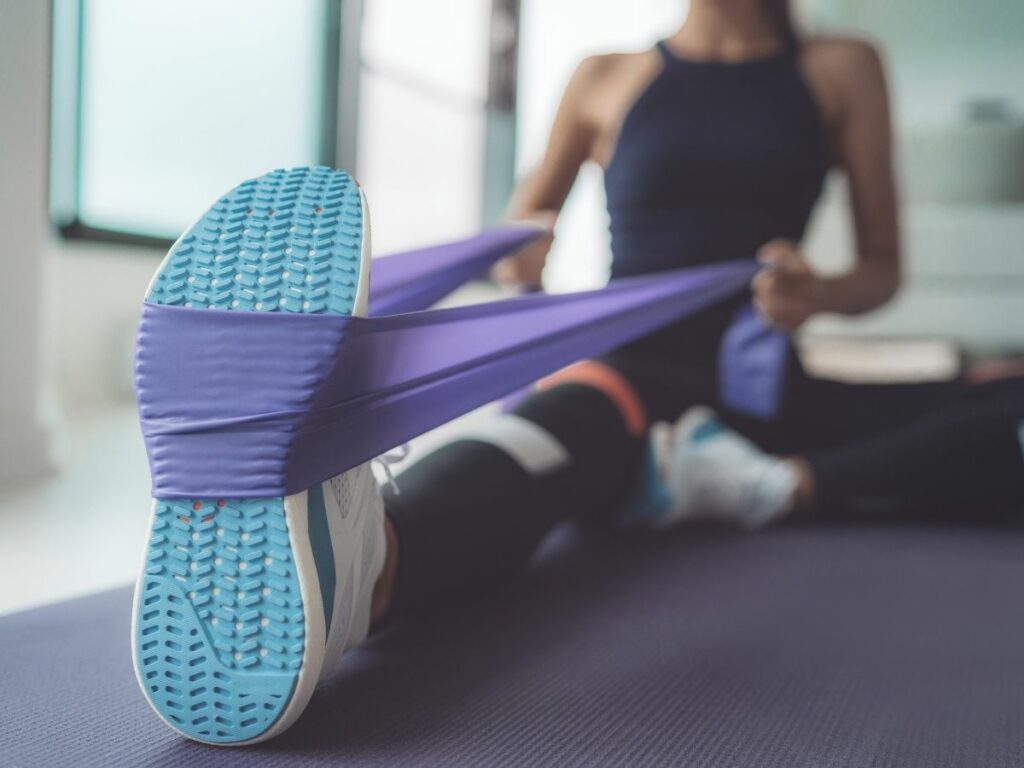
Postural Corrections and Ergonomic Adjustments
Posture correction goes beyond the clinic. Your therapist may review how you sit, stand, and sleep. For desk workers, raising your computer monitor to eye level, relaxing the shoulders, and keeping elbows close to the body can significantly ease strain. For drivers, adjusting the seat height and steering wheel angle helps reduce forward shoulder rotation a common trigger for TOS.
Consistency is essential. Patients who practice their prescribed stretches daily and incorporate ergonomic adjustments often report noticeable improvements within six to eight weeks. While results vary, physical therapy remains the safest and most sustainable path to recovery for most TOS cases.

Medications and Pain Management For Thoracic Outlet Syndrome
When pain, inflammation, or nerve irritation becomes too uncomfortable, medications can provide temporary relief and make therapy more tolerable. The goal isn’t to mask symptoms but to create a pain-free window that allows you to stay active and committed to long-term rehabilitation.
Pain management for thoracic outlet syndrome involves controlling inflammation, reducing muscle tension, and calming irritated nerves so functional recovery can continue. Nonsteroidal anti-inflammatory drugs (NSAIDs) such as ibuprofen, naproxen, or meloxicam are typically the first line of treatment. These help reduce swelling and relieve mild to moderate pain, especially when symptoms flare after repetitive motion.

For nerve-related discomfort, like burning, tingling, or numbness, doctors may prescribe neuropathic agents such as gabapentin or pregabalin. These medications target the overactive nerve signals that contribute to chronic pain. In cases where muscle spasm contributes to compression, short-term use of muscle relaxants may be helpful.
It’s important to note that medications don’t cure the root cause of TOS. They serve as complementary tools alongside therapy, posture work, and lifestyle changes. Patients are usually advised to use them for a limited period under medical supervision to avoid side effects or dependency.
Lifestyle Modifications for Lasting Relief
Beyond medical and physical interventions, daily habits often make or break recovery from thoracic outlet syndrome. Small, mindful adjustments to your lifestyle can prevent the compression from worsening and support healing over time.
Lifestyle modification in thoracic outlet syndrome treatment is about reducing strain on the neck, shoulders, and upper chest while promoting balance, circulation, and flexibility. If you’re used to carrying heavy bags on one shoulder, switching sides or using a backpack distributes weight evenly and prevents additional pressure. Likewise, sleeping with arms above your head or propped on high pillows can aggravate nerve compression, so a neutral sleeping posture is recommended.
Your job or hobbies may also play a role. Repetitive tasks like painting, typing, or assembly-line work can tighten the muscles surrounding the thoracic outlet. Taking regular breaks, stretching your shoulders, and rotating your activities throughout the day can significantly reduce tension.
Another crucial element is staying physically active. Low-impact activities such as swimming, walking, or yoga (with therapist approval) keep the upper body flexible and improve blood flow. Some patients also benefit from deep breathing exercises that gently expand the chest cavity, creating more space for nerves and vessels.
These modifications might seem simple, but over time, they enhance the effects of therapy and lower the risk of recurrence. Recovery often depends as much on what you do at home and work as what happens in the clinic.



Minimally Invasive Treatments
When conservative options provide only partial relief, doctors may recommend minimally invasive procedures, such as injections. These serve both diagnostic and therapeutic purposes, helping confirm the source of compression while offering pain reduction that supports ongoing rehabilitation.
Injections for thoracic outlet syndrome are designed to target inflammation or muscle tightness directly at the site of compression, providing temporary but meaningful relief. They are particularly useful for patients with muscle-based (neurogenic) TOS, where tight scalene or pectoralis muscles are the main culprits.
1. Botulinum Toxin (Botox) Injections
Botox injections temporarily relax overactive muscles, especially the scalene or pectoralis minor, that are pressing against nerves or vessels. The effects last about three to four months, giving patients time to continue physical therapy with reduced pain and improved mobility. Botox can also serve as a diagnostic tool; if symptoms improve after injection, it confirms that muscle tension is the likely cause.
2. Corticosteroid Injections
Corticosteroids are powerful anti-inflammatory agents. Injecting them near compressed nerves can reduce swelling and irritation, easing pain for several weeks or months. This approach is particularly helpful for patients who need symptom relief to stay active in therapy. However, steroids are not a long-term solution and are used sparingly due to potential side effects like tissue thinning.
3. Nerve Blocks
A nerve block involves injecting a local anesthetic near the affected nerves to temporarily stop pain signals. Beyond providing short-term relief, nerve blocks also help doctors identify which nerve pathways are involved. If pain disappears after the injection, it indicates that the targeted area is the true source of the problem, guiding future treatment decisions.
While injections can be highly effective, they are best viewed as one component of a larger care plan. Your healthcare provider will assess whether you are a good candidate based on your symptom pattern, response to previous therapy, and imaging results.
Surgical Options for Severe Cases
In rare cases, when non-surgical approaches fail or when vascular compression causes serious complications like blood clots or circulation loss, surgery becomes necessary. Surgical intervention aims to physically remove or relieve whatever is compressing the thoracic outlet.
Surgical thoracic outlet syndrome treatment is reserved for patients with persistent symptoms or vascular compromise, and it focuses on eliminating the structural causes of compression. Depending on the specific type of TOS (neurogenic, venous, or arterial) different procedures are performed.
- For Neurogenic TOS: The most common type, surgery may involve removing the first rib (first rib resection) or cutting the scalene muscles (scalenectomy) to relieve pressure on nerves.
- For Venous or Arterial TOS: Surgeons may repair or reconstruct damaged blood vessels and remove any abnormal tissue or bone spurs contributing to the blockage.
These procedures can be done through a small incision near the collarbone or under the arm, depending on the surgeon’s approach. Postoperative recovery involves physical therapy to restore shoulder motion and rebuild strength. Most patients notice gradual symptom relief over several months.
As with any surgery, there are risks, such as infection, nerve injury, or persistent pain, but with modern techniques and skilled surgical teams, outcomes are generally favorable when the indication is clear and rehabilitation is followed faithfully.

Complementary and Alternative Therapies
While conventional medicine forms the foundation of TOS management, many patients turn to complementary therapies to ease discomfort and enhance recovery. Complementary treatments for thoracic outlet syndrome focus on promoting relaxation, improving circulation, and reducing muscle tension to complement medical care. Acupuncture, for instance, uses fine needles to stimulate blood flow and release muscle knots, potentially reducing pain intensity.
Chiropractic adjustments, when performed by practitioners familiar with TOS anatomy, can help realign the spine and shoulders. Similarly, massage therapy and myofascial release target tight connective tissues, encouraging flexibility and better posture. Another emerging option is dry needling, a technique that targets specific trigger points to deactivate muscle spasms and restore movement.
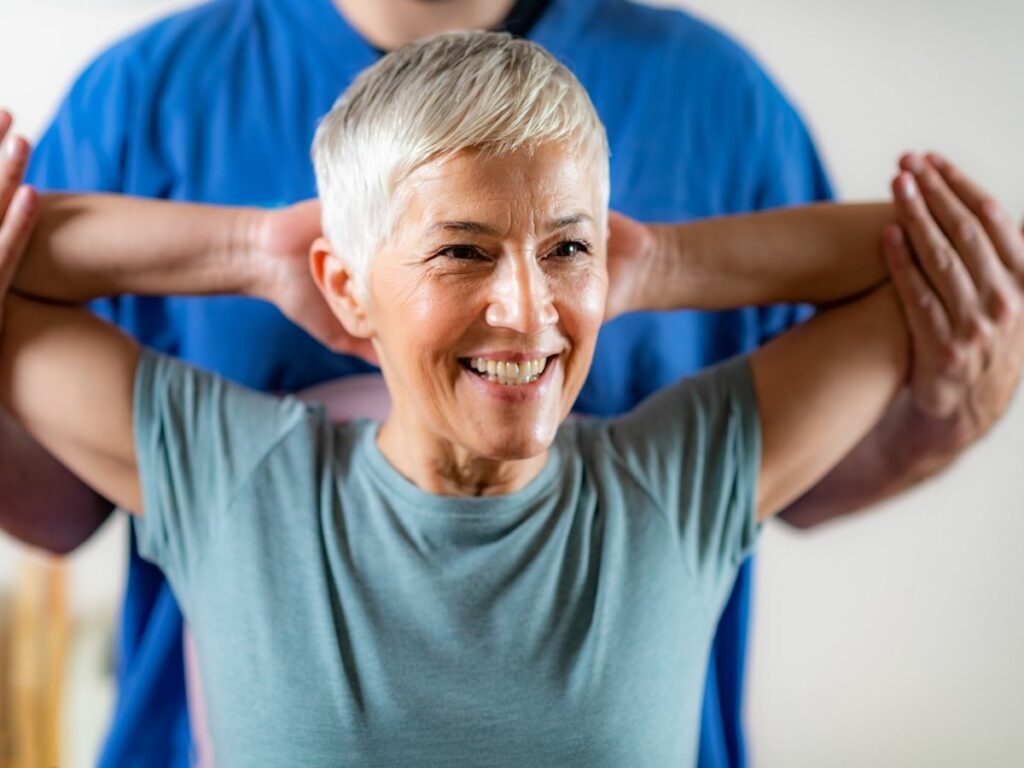
Patients often pair these treatments with traditional therapy for a more holistic approach. Though not all complementary therapies have strong clinical evidence, many individuals report subjective improvement in pain levels and function. It’s always best to consult your healthcare provider before starting alternative treatments to ensure they’re safe and compatible with your current plan.
Should You Consider Injections for Pain Relief?
For some people, the most challenging part of managing TOS is persistent pain that resists therapy and medication. In such cases, injections may offer a bridge between conservative and surgical options. Injections play a valuable role in thoracic outlet syndrome treatment by providing targeted, temporary relief that allows patients to continue progress in physical therapy and daily life. They can help break the pain cycle, improve range of motion, and provide diagnostic clarity about the root cause.
However, injections should be viewed as supportive tools rather than standalone solutions. They don’t correct posture, muscle imbalance, or anatomical abnormalities. The best results come when injections are paired with ongoing exercises, ergonomic changes, and medical supervision.
If your symptoms remain severe despite months of therapy, your physician might recommend an imaging-guided injection to confirm muscle involvement or relieve inflammation. The decision should always be made collaboratively, weighing the benefits against potential risks like temporary soreness or rare allergic reactions.
Ultimately, the goal of TOS treatment, whether through therapy, injections, or surgery, is not just to stop pain but to restore full and confident use of your arms and shoulders. With patience, consistent effort, and the right multidisciplinary approach, long-term relief is achievable.
Finding a comfortable sleeping position when you have sacroiliac (SI) joint pain can feel impossible. The wrong posture can trigger sharp aches that travel from your lower back to your hips and thighs, disrupting your rest.
The right position, however, can ease pressure on the joint, reduce inflammation, and help you wake up with less stiffness. The best sleeping position for sacroiliac joint pain relief usually involves supporting your spine’s natural curve and preventing your hips from twisting. With a few practical adjustments and the right pillows, restful sleep becomes possible again. Let's dive into the best sleeping positions for sacroiliac joint pain relief .
Understanding Sacroiliac Joint Pain
The sacroiliac joints sit where the base of your spine meets your pelvis. These small but powerful joints transfer weight from the upper body to the legs, stabilizing you when you walk, bend, or stand. When inflammation or misalignment occurs, even small movements can cause deep pain on one or both sides of the lower back.
SI joint pain can stem from several causes such as arthritis, pregnancy, injury, or prolonged poor posture. Sleeping in awkward positions that twist the pelvis can worsen symptoms overnight. People often describe the discomfort as a dull ache that intensifies when they roll over or get out of bed.
The key to sleeping comfortably with SI joint pain is maintaining alignment between your spine, hips, and legs so the joint remains neutral rather than strained. Good sleep posture supports recovery by reducing mechanical stress on this sensitive area.
Best Sleeping Positions for Sacroiliac Joint Pain Relief
Everyone’s body is different, so finding the right position may take some trial and error. However, certain postures consistently reduce tension on the sacroiliac joints and promote proper spinal alignment. Supportive pillows and a medium-firm mattress often make these positions even more effective.
Side Sleeping with a Pillow Between the Knees

Side sleeping is one of the most recommended positions for SI joint pain relief. When you lie on your side, the pelvis can easily rotate or tilt, which puts uneven stress on the sacroiliac joint. Placing a firm pillow between your knees helps keep your hips stacked and your spine aligned from shoulders to knees.
If your pain is worse on one side, try sleeping on the opposite side to reduce direct pressure on the affected joint. You can also tuck a small pillow under your waist to support your midsection and prevent sagging.
This position keeps the pelvis stable and reduces strain on the lower back, promoting even weight distribution throughout the night.
How to Set It Up:
- Lie on your side with both knees slightly bent.
- Place a supportive pillow between your knees so they remain hip-width apart.
- Hug a second pillow to your chest for upper-body balance.
- If you notice a gap at your waist, fill it with a small cushion for spinal support.
This setup minimizes twisting and works especially well for individuals with one-sided SI pain or hip tightness.
Back Sleeping with Knee Support
Sleeping on your back allows your weight to spread evenly, relieving direct pressure from the sacroiliac area. However, lying flat can sometimes cause your lower spine to arch excessively, irritating the joints. Placing a pillow or wedge under your knees flattens that curve and keeps your pelvis neutral.
Some people prefer using a contoured memory-foam pillow under the knees to maintain stable support. Others find that slightly elevating the legs with an adjustable bed base eases pain further.
Back sleeping with knee elevation helps reduce the compressive forces that aggravate sacroiliac joint inflammation. It also promotes circulation and minimizes morning stiffness.
Try this setup:
- Use a medium-firm mattress that supports the natural curve of your lower back.
- Place a thick pillow under your knees and another beneath your head and neck.
- Keep your arms relaxed at your sides or rest them on your abdomen.
If you tend to snore, slightly raising your upper body with an adjustable bed or wedge pillow can make breathing easier while preserving hip alignment.
Modified Fetal Position for Comfort
A modified fetal position can work for people who prefer curling slightly while sleeping. It relieves tension in the lumbar region while keeping the hips relatively aligned. To avoid straining the sacroiliac joint, avoid curling too tightly. The key is a relaxed curve, not a deep hunch.
Placing a pillow between the knees and one behind your back for support keeps your pelvis from rotating. Some people also benefit from hugging a long body pillow, which prevents rolling into awkward angles during the night.
The modified fetal position reduces lower-back tension while maintaining hip symmetry and promoting deep relaxation.
Quick Comparison: Best Positions for SI Joint Pain
| Sleeping Position | Benefits | Ideal For |
| Side with Pillow Between Knees | Aligns hips and reduces rotation | One-sided or pregnancy-related SI pain |
| Back with Pillow Under Knees | Evenly distributes weight, relaxes spine | Bilateral SI pain or stiffness |
| Modified Fetal Position | Comforts lumbar area, prevents twisting | Restless sleepers or those needing full-body support |
Using these setups consistently can make a noticeable difference in how you feel when you wake up. The right position not only relieves pain but also improves sleep quality by keeping muscles relaxed.
Avoiding Positions That Make SI Joint Pain Worse
While supportive postures can soothe your joints, certain sleeping habits can make symptoms worse. Being mindful of these can prevent overnight flare-ups and long-term irritation.
Stomach Sleeping
Lying on your stomach twists the pelvis and strains the lower back. This position forces one side of the hip to lift higher, putting uneven tension on the sacroiliac joint. Over time, it can lead to chronic tightness and nerve irritation.
If you cannot avoid stomach sleeping, place a thin pillow under your hips and use a very flat pillow or none at all under your head. This helps reduce the spinal curve, though side or back sleeping remains the better option.
Uneven Mattress or Pillow Setup
A sagging mattress or an overly soft bed can sink your hips too deeply, causing misalignment through the night. The same happens if you use pillows that are too high or too flat. A medium-firm mattress with adaptive foam or hybrid support is ideal for maintaining even pressure on the spine and pelvis.
If you notice more pain in the morning, check for dips or wear spots on your mattress and consider adding a firm topper or replacing the mattress entirely.
Twisting Movements in Bed
Turning abruptly or sleeping with one leg bent across the other can trigger sacroiliac joint irritation. To minimize twisting, keep both legs together when rolling over and move your upper and lower body simultaneously. You can also use a long body pillow to prevent your top leg from sliding forward during the night.
Avoiding poor sleeping positions is as important as finding the right ones. Maintaining consistency each night trains your body to stay in a neutral alignment, which reduces inflammation and supports healing.
Additional Tips for Nighttime SI Joint Relief
Comfortable sleeping positions are just part of the solution. Lifestyle and bedtime adjustments can further ease pain and help you rest better.
Stretching and Mobility Before Bed
Gentle stretches before bedtime relax tight muscles around the hips and lower back. Focus on the glutes, hamstrings, and hip flexors. Try movements like:
- Knee-to-chest stretch: Pull one knee toward your chest while lying on your back, hold for 20 seconds, and switch sides.
- Piriformis stretch: Sit with one ankle over the opposite knee and lean forward slightly to feel a stretch in your outer hip.
These light stretches increase flexibility and reduce tension that can pull on the sacroiliac joint during sleep.
Choosing the Right Mattress and Pillows
Your mattress can either support your recovery or worsen pain. Choose one that balances comfort and firmness, ideally medium-firm, so it conforms to your body without sagging. Memory-foam or latex hybrids tend to offer the best combination of contouring and stability.
Pillows should maintain neck alignment and support the natural curve of your spine. A contoured cervical pillow or wedge can be helpful for back sleepers, while side sleepers should choose a pillow thick enough to keep the neck in line with the shoulders.
Investing in proper bedding is one of the most effective ways to reduce nightly SI joint discomfort.
Use Heat or Ice Before Bed
Applying a heating pad or warm compress for 15 minutes before sleep can loosen tight muscles and improve circulation. For acute inflammation, a brief cold compress can calm the joint and minimize swelling. Alternate between heat and ice if needed, depending on how your body responds.
Maintain Healthy Sleep Hygiene
Small changes in your bedtime routine can enhance rest and minimize tossing and turning:
- Go to bed and wake up at consistent times.
- Avoid heavy meals and caffeine close to bedtime.
- Keep your bedroom cool and dark.
- Limit screen time to reduce muscle tension from prolonged sitting or phone use.
Creating a calm environment allows your muscles to relax fully, reducing the likelihood of nighttime joint flare-ups.
Morning Transition Tips
How you get out of bed matters too. Rolling to one side, bending your knees, and using your arms to push yourself upright prevents sudden pressure on the sacroiliac joint. Stretch gently once you stand to awaken the supporting muscles before walking.
Combining proper posture, supportive bedding, and nightly self-care practices maximizes pain relief and helps restore a natural sleep rhythm.
How To Relieve Hand Pain at Night with Simple Techniques
If your lower back is not the only area disturbing your sleep, nighttime hand pain can be just as disruptive. Many people who find relief from sacroiliac joint pain later struggle with numbness or tingling in their wrists or fingers. These symptoms often result from nerve compression, poor circulation, or repetitive strain.
The same principle that applies to your lower back alignment applies to your hands and wrists. Keeping your joints neutral during rest prevents unnecessary pressure. Wearing soft wrist splints at night, doing gentle hand stretches before bed, and avoiding sleeping with wrists bent under your pillow can make a noticeable difference.
Applying a warm compress before sleep or gently massaging your hands with lotion can also improve circulation. If you use your hands heavily during the day, consider alternating heat and cold therapy to calm inflammation.
Improving sleep posture throughout your body, not just your lower back, is the foundation of overall joint health. With consistent habits and mindful positioning, you can reduce discomfort from both sacroiliac joint pain and nighttime hand aches helping you sleep soundly and wake up ready to move freely again.
Menopause joint pain is best managed through a mix of healthy lifestyle habits, targeted exercise, balanced nutrition, and, when needed, medical treatments like hormone therapy or anti-inflammatory medication. Combining movement, an anti-inflammatory diet, and proper hydration can help reduce discomfort and improve mobility.
This guide explains how to treat menopause joint pain. We will look at why menopause can trigger joint pain, its common symptoms, risk factors and effective relief options from supplements and natural remedies to medical care. You’ll also learn when it’s time to consult a doctor for lasting joint health.
The Connection: Why Menopause Causes Joint Pain
During menopause, many women experience new or worsening joint discomfort. This is not just a normal part of aging — hormonal changes play a major role in how the joints feel and function.
1. Declining Estrogen Levels
Estrogen helps reduce inflammation, maintain cartilage, and keep joints lubricated. When levels drop during menopause, the protective effect weakens, making joints more prone to stiffness, swelling, and pain.
2. Loss of Muscle Mass and Bone Density
Aging and hormonal changes can lead to sarcopenia (muscle loss) and osteoporosis, which reduce joint support and increase the risk of wear-and-tear injuries. This can make everyday movements more taxing on the joints.
3. Increased Inflammation and Weight Gain
Lower estrogen levels can trigger a rise in inflammatory chemicals in the body. Combined with weight gain common in menopause, this puts extra pressure on weight-bearing joints like the knees and hips.
Understanding these connections can help women take proactive steps — from targeted exercise to hormone management — to protect joint health and ease discomfort during menopause.
Treatment Approaches for Menopause Joint Pain
Managing menopause joint pain often requires a multi-faceted approach that combines lifestyle adjustments, nutritional support, natural therapies, and, when needed, medical care. The aim is to reduce inflammation, strengthen the body’s support structures, and prevent long-term joint damage.
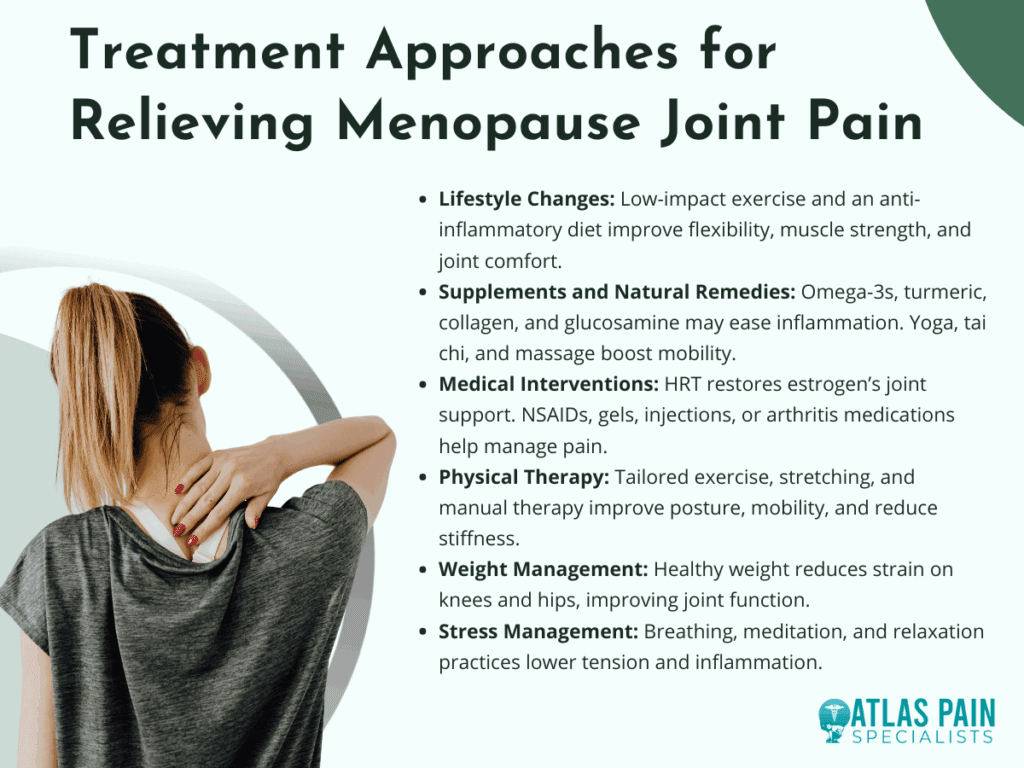
1. Lifestyle Changes
Regular low-impact exercises such as swimming, walking, Pilates, or cycling help maintain flexibility and strengthen the muscles that protect joints. Coupling physical activity with an anti-inflammatory diet rich in vegetables, omega-3s, and lean proteins can improve mobility and reduce discomfort.
2. Supplements and Natural Remedies
Omega-3 fatty acids, turmeric, collagen peptides, and glucosamine may support joint structure and decrease inflammation. Complementary therapies like acupuncture, yoga, tai chi, and massage can improve circulation, flexibility, and overall comfort.
3. Medical Interventions
Hormone Replacement Therapy (HRT) may help restore estrogen’s anti-inflammatory benefits and protect cartilage health. For pain management, doctors may recommend NSAIDs, topical anti-inflammatory gels, corticosteroid injections, or medications for arthritis-related conditions.
4. Physical Therapy and Rehabilitation
A physical therapist can create a tailored exercise plan to strengthen joint-supporting muscles, improve posture, and enhance mobility. Targeted stretching and manual therapy can also help reduce stiffness and pain.
5. Weight Management
Maintaining a healthy weight reduces the load on weight-bearing joints like the knees and hips, easing discomfort. Even modest weight loss can significantly improve mobility and joint function.
6. Stress Management
Chronic stress can increase inflammation and make pain feel more intense. Techniques such as deep breathing, meditation, and progressive muscle relaxation can help reduce tension and support overall joint health.
By combining these strategies, women can take control of menopause-related joint pain, improve daily comfort, and protect their mobility well into the future.
Symptoms to Watch For
Menopause joint pain can develop gradually or appear suddenly, often affecting daily comfort and mobility. Recognizing early warning signs helps in addressing the problem before it becomes more severe.
1. Morning Stiffness
Many women notice their joints feel tight and difficult to move upon waking. This stiffness typically eases with gentle activity but may return after periods of inactivity.
2. Joint Swelling and Tenderness
Reduced estrogen can lead to inflammation, causing joints to appear puffy or feel warm to the touch. Swelling often makes movement uncomfortable and can limit range of motion.
3. Clicking or Grinding Sensations
Loss of cartilage or changes in joint lubrication can cause cracking or popping sounds during movement. While not always painful, these sensations may signal early joint wear.
4. Reduced Flexibility and Range of Motion
Joints may feel less mobile, making activities like climbing stairs or bending more difficult. This stiffness can progress without targeted stretching or exercise.
5. Persistent Aching or Pain
Discomfort may occur during activity or at rest, affecting knees, hips, shoulders, or smaller joints in the hands. Over time, this can interfere with sleep and daily tasks.
Identifying these symptoms early allows for quicker treatment, which can help preserve joint function and prevent long-term damage. Monitoring changes in your body is key to managing menopause-related joint issues effectively.
Risk Factors for Menopause-Related Joint Pain
Certain factors can increase the likelihood of experiencing joint pain during menopause. Understanding these risks can help you take preventive steps and make lifestyle choices that protect joint health.
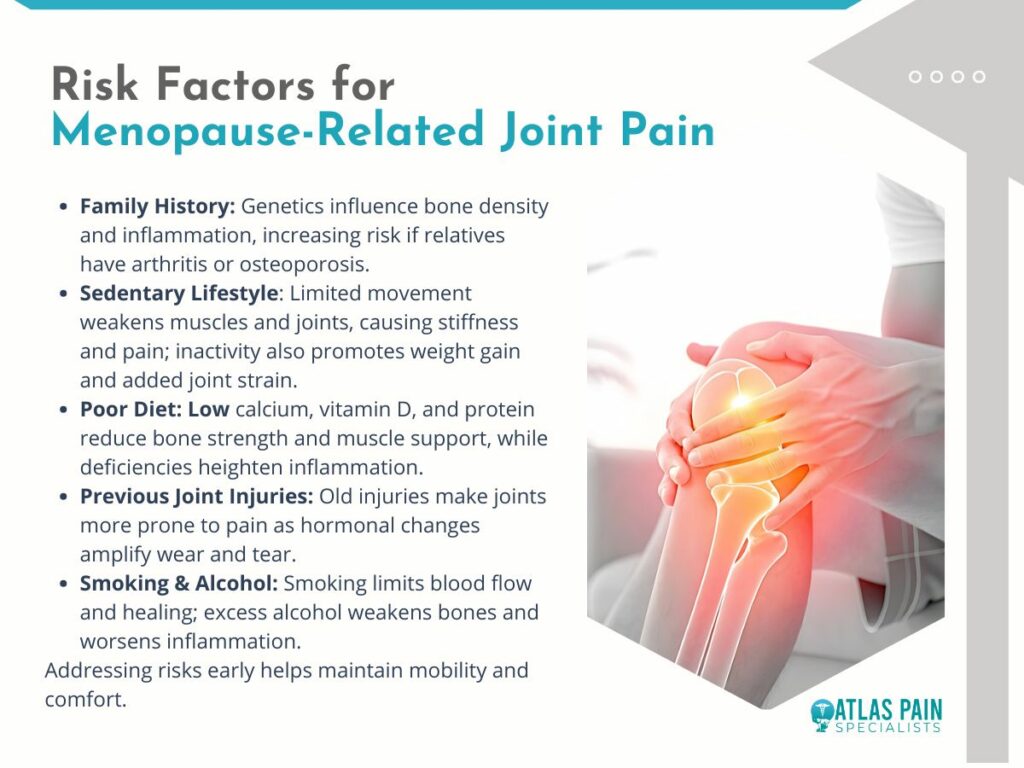
1. Family History of Arthritis or Osteoporosis
Genetics can play a strong role in joint health, influencing cartilage strength, bone density, and inflammatory responses. If close relatives have these conditions, your risk may be higher during menopause.
2. Sedentary Lifestyle
Lack of regular movement weakens muscles and reduces joint flexibility, making them more vulnerable to stiffness and pain. A sedentary routine can also contribute to weight gain, adding extra strain to joints.
3. Poor Diet Lacking Essential Nutrients
Diets low in calcium, vitamin D, and protein can weaken bones and muscles, reducing the body’s ability to support and protect joints. Nutrient deficiencies may also increase inflammation.
4. Previous Joint Injuries
Old injuries can leave joints more susceptible to wear and tear over time. Menopause-related changes may worsen discomfort or stiffness in these areas.
5. Smoking and Excessive Alcohol Use
Smoking reduces blood flow to joints, slowing healing and increasing inflammation. Excess alcohol intake can also weaken bones and contribute to poor joint health.
Recognizing your risk factors is the first step toward prevention. By addressing lifestyle habits early, you can reduce your chances of experiencing severe menopause joint pain and protect your mobility for years to come.
Natural and Alternative Remedies
Natural and alternative approaches can complement medical treatment for menopause joint pain, helping to reduce inflammation, improve flexibility, and support overall well-being. These options often focus on whole-body balance and gentle, non-invasive care.
1. Acupuncture
This traditional Chinese therapy involves inserting fine needles into specific points to stimulate healing and reduce inflammation. Many women report improved mobility and less joint discomfort after regular sessions.
2. Massage Therapy
Targeted massage can relieve muscle tension around affected joints, improve blood flow, and promote relaxation. Regular sessions may also help reduce stiffness and improve range of motion.
3. Yoga and Tai Chi
These gentle, low-impact practices improve flexibility, strengthen muscles, and promote better posture. They also enhance mindfulness, which can help manage the perception of pain.
4. Herbal Supplements
Turmeric, ginger, and Boswellia are known for their natural anti-inflammatory properties. When taken appropriately, they may reduce swelling and joint discomfort, though consultation with a healthcare provider is advised.
5. Heat and Cold Therapy
Applying heat can relax muscles and improve circulation, while cold packs help reduce swelling and numb sharp pain. Alternating between the two may offer additional relief.
Integrating natural remedies into your routine can provide extra support in managing menopause joint pain, especially when combined with healthy lifestyle habits and medical guidance. Always consult a professional before starting new treatments to ensure they’re safe for your individual needs.
Medical Treatment Options
When lifestyle changes and natural remedies are not enough, medical treatments can help address the root causes of menopause joint pain and provide stronger symptom relief. These approaches are best tailored to each individual’s health needs and risk factors.
1. Hormone Replacement Therapy (HRT)
HRT can help restore estrogen levels, reducing inflammation and supporting joint health. It may also relieve other menopause symptoms, though it’s important to discuss potential risks and benefits with a healthcare provider.
2. Nonsteroidal Anti-Inflammatory Drugs (NSAIDs)
Over-the-counter options like ibuprofen or naproxen can ease pain and reduce swelling. They are useful for flare-ups but should be taken as directed to avoid side effects.
3. Topical Anti-Inflammatory Treatments
Gels or creams containing diclofenac or capsaicin can be applied directly to painful joints. These provide targeted relief with fewer systemic side effects than oral medications.
4. Corticosteroid Injections
For severe pain or inflammation, doctors may recommend steroid injections into the affected joint. These can offer fast relief, though repeated use is generally limited due to potential joint damage.
5. Prescription Medications for Arthritis
If menopause symptoms overlap with arthritis, disease-specific medications may be prescribed. These help manage inflammation and slow joint damage progression.
Medical interventions can be highly effective when used alongside healthy lifestyle habits. Working closely with a healthcare provider ensures you choose the safest and most effective options for your situation.
When to Seek Urgent Medical Care
While most menopause-related joint pain can be managed with lifestyle changes and regular care, certain symptoms may indicate a more serious condition. Prompt medical attention can prevent complications and ensure proper treatment.
- Sudden, Severe Joint Pain - Intense pain that comes on quickly could signal a serious injury, infection, or inflammatory flare-up requiring immediate evaluation.
- Visible Joint Deformity - Any sudden change in joint shape or alignment may indicate dislocation, fracture, or advanced arthritis that needs urgent care.
- Signs of Infection - Redness, warmth, swelling, and fever around a joint can point to a joint infection, which is a medical emergency.
- Unexplained Fever with Joint Pain - This combination can indicate an underlying inflammatory or infectious condition that requires prompt testing and treatment.
- Loss of Mobility or Function - Inability to bear weight or move a joint normally may mean structural damage or severe inflammation that needs immediate attention.
If you notice any of these symptoms, seek medical care right away to prevent long-term damage and address potential underlying health issues.
Bottom Line
Menopause joint pain may be a natural result of hormonal changes, but it doesn’t have to limit your quality of life. With the right mix of lifestyle adjustments, natural remedies, and medical care, it’s possible to reduce discomfort, improve mobility, and protect joint health for the long term.
Listening to your body, addressing symptoms early, and working closely with a healthcare provider are key to effective management. By taking proactive steps, you can stay active, independent, and pain-free well beyond menopause.
Living with anxiety is difficult enough, but when nerve pain joins the picture, the discomfort can feel overwhelming. The sharp, burning, or tingling sensations that travel along nerves are often intensified by stress. Anxiety does not always cause nerve pain directly, but it can heighten sensitivity in the nervous system, making existing discomfort worse and sometimes even triggering new sensations. Learning how to stop anxiety nerve pain involves a mix of calming the mind, protecting the body, and developing habits that support both mental and physical health.
Below we break down the relationship between anxiety and nerve pain, practical strategies for relief, and long-term approaches that bring control back into your hands.
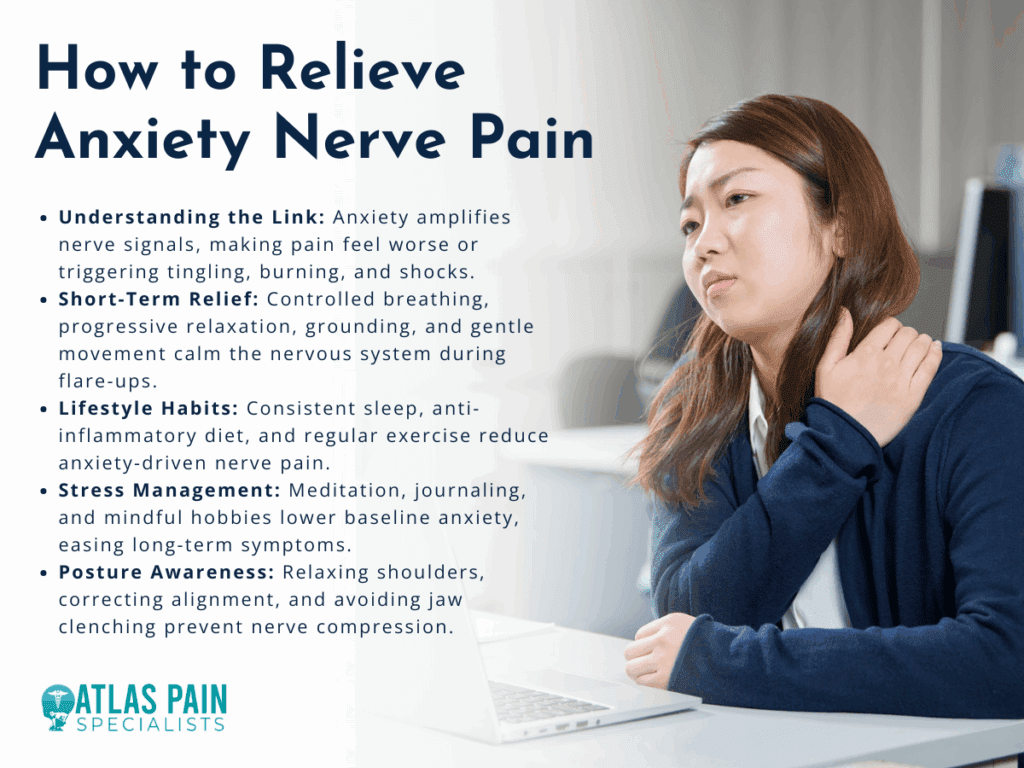
Understanding Anxiety-Related Nerve Pain
When people first experience nerve pain during an anxious period, it can be confusing. Anxiety can cause muscle tightness, disrupted blood flow, and overactive nerve signaling. These physical reactions sometimes create sensations similar to neuropathy, such as pins and needles, burning, or electric-like shocks.
The key idea is that anxiety amplifies the nervous system’s signals, making pain feel more intense than it would under calm conditions. For example, if you are already dealing with a pinched nerve, stress hormones like cortisol may heighten your sensitivity to the discomfort. Even in the absence of an existing injury, anxiety can cause body sensations that mimic nerve pain because of constant muscle tension and misfired nerve communication.
Understanding this connection is important. It shifts the perspective from worrying about mysterious symptoms to realizing that the brain and body are linked. Once you recognize the role anxiety plays, you can begin addressing both the physical discomfort and the mental stress that feeds into it.
Short-Term Relief Techniques
Calming nerve pain in the moment often means giving your body and mind a chance to reset. These are methods that can be used during flare-ups to ease symptoms and prevent spirals of anxiety.
The most effective short-term relief combines relaxation with gentle body awareness. When you slow down your stress response, the nervous system becomes less reactive.
Controlled Breathing
Breathing exercises may seem simple, but they directly influence how the nervous system functions. Slow, deep breaths reduce the “fight or flight” response that fuels nerve pain sensitivity. One method is box breathing: inhale for four counts, hold for four, exhale for four, hold again for four, and repeat several times.
Progressive Muscle Relaxation
Tight muscles put pressure on nerves, which can worsen pain. With progressive muscle relaxation, you tense one muscle group at a time for a few seconds, then release. This helps the body recognize the difference between tension and relaxation, often leading to reduced nerve irritation.
Grounding Exercises
Sometimes nerve pain worsens when attention is focused too intensely on it. Grounding techniques, like naming five things you can see, four you can touch, three you can hear, two you can smell, and one you can taste, bring the brain back to the present moment instead of cycling through anxious sensations.
Gentle Movement
If the pain allows, slow stretches or light walking improve circulation and reduce stiffness. Even a few minutes of shoulder rolls or neck stretches can ease nerve compression and help the body relax.
Lifestyle Adjustments for Long-Term Comfort
Managing anxiety-related nerve pain is not just about handling flare-ups. The way you eat, sleep, move, and handle daily stress determines how often and how severe the pain becomes.
Long-term relief from anxiety nerve pain requires steady lifestyle habits that calm the nervous system and strengthen the body. This does not mean a total life overhaul in a single week. Small, consistent changes build resilience over time.
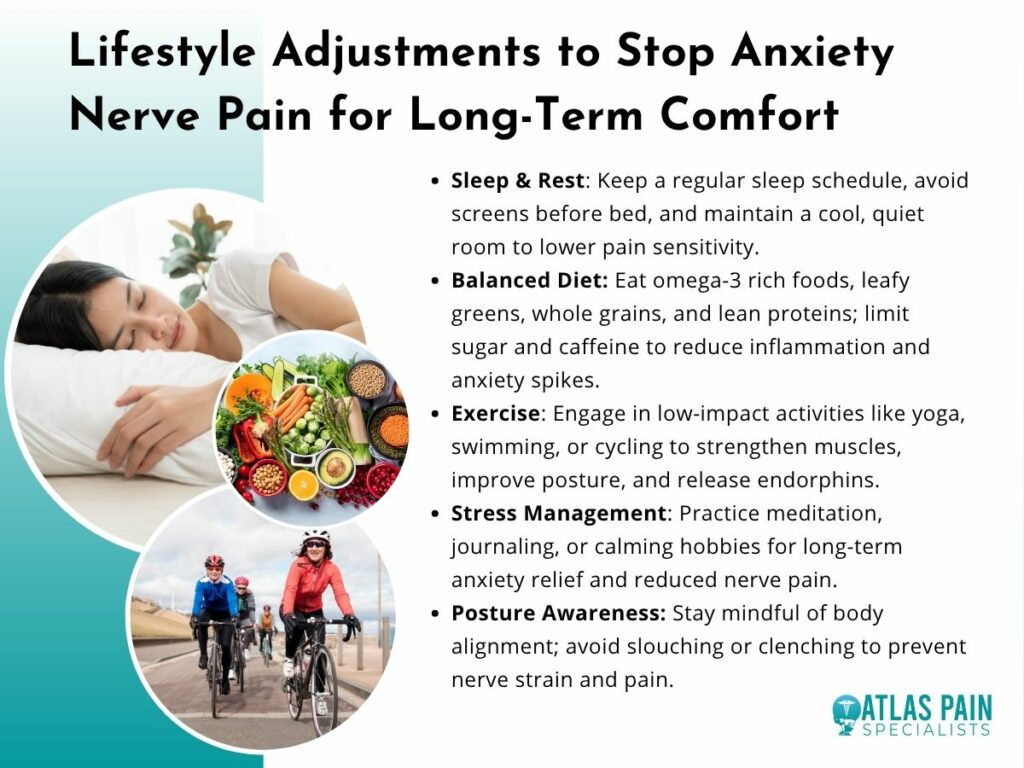
Sleep and Rest
Poor sleep increases both pain sensitivity and anxiety. Aiming for consistent bedtimes, limiting screen exposure before sleep, and keeping the bedroom cool and quiet can help restore restorative rest. When the brain is rested, the body interprets pain signals less harshly.
Balanced Diet
Inflammation makes nerve pain worse, and stress hormones are also affected by diet. Including foods rich in omega-3 fatty acids, leafy greens, whole grains, and lean proteins helps stabilize mood and reduce inflammation. Avoiding excessive caffeine and sugar prevents spikes in anxiety that can aggravate pain.
Exercise
Physical activity strengthens muscles, improves posture, and reduces chronic tension. Low-impact exercises like swimming, yoga, and cycling are particularly helpful for nerve health. Beyond physical benefits, exercise triggers endorphins, which naturally counter both anxiety and pain.
Stress Management
Incorporating regular stress-reducing practices makes a difference over time. Meditation, journaling, or mindful hobbies like painting or gardening create mental breaks from constant stress. Over weeks and months, this lowers baseline anxiety, which in turn reduces nerve pain sensitivity.
Posture Awareness
Many anxiety sufferers unconsciously hunch their shoulders or clench their jaw. These habits create nerve compression, especially in the neck and back. Paying attention to body alignment during daily tasks can ease strain and prevent pain.
Common Triggers That Worsen Anxiety Nerve Pain
Even when practicing good self-care, certain daily habits or situations can flare up nerve pain. Recognizing these triggers makes it easier to avoid unnecessary discomfort.
Anxiety nerve pain often worsens because of small lifestyle factors that overstimulate the nervous system or strain the body. Becoming aware of them provides another layer of control.
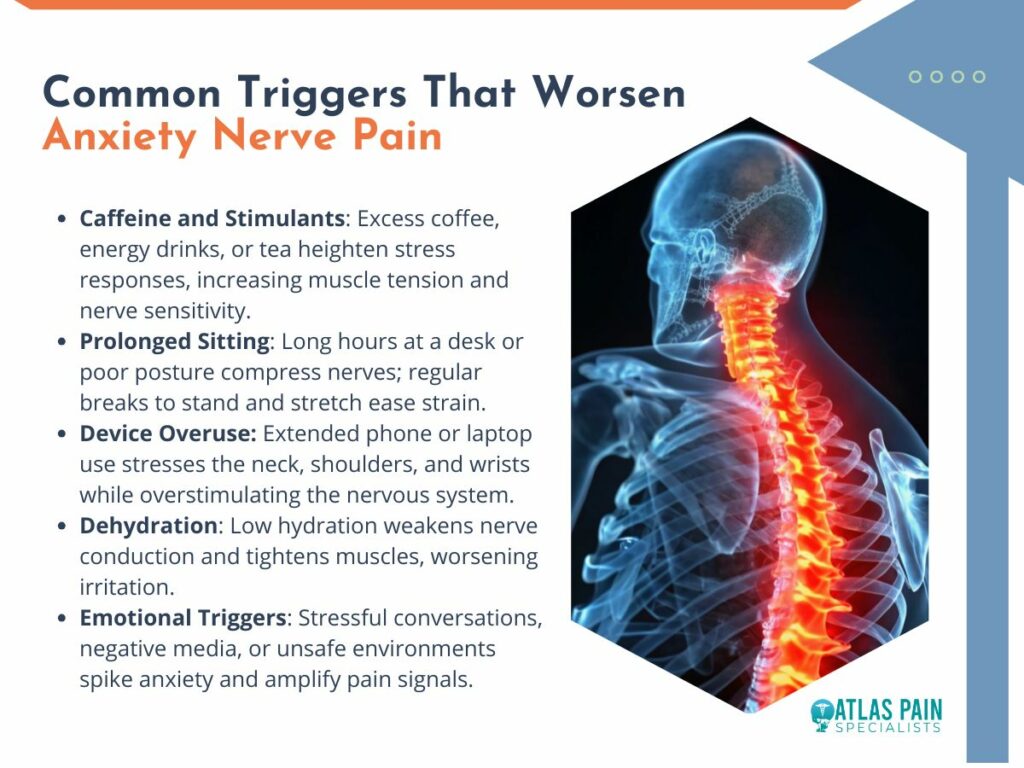
Caffeine and Stimulants
Caffeine may increase alertness, but it also heightens the body’s stress response. Too much coffee, energy drinks, or even strong tea can trigger jitters, muscle tension, and nerve sensitivity.
Prolonged Sitting
Sitting for long periods, especially at desks or with poor posture, compresses nerves in the spine and legs. Breaks to stand, stretch, or walk every hour can reduce flare-ups.
Device Overuse
Constant phone scrolling or laptop use without breaks strains the neck, shoulders, and wrists. This creates nerve compression while also feeding anxiety with overstimulation.
Dehydration
When the body lacks hydration, nerve conduction is less efficient, and muscles become tighter, which may worsen nerve irritation. Drinking water regularly throughout the day supports smoother nerve function.
Emotional Triggers
Stressful conversations, news consumption, or environments that feel unsafe can all spike anxiety, which in turn heightens pain signals. Creating healthy boundaries with media and people helps reduce this effect.
Comparison: Short-Term vs. Long-Term Strategies
| Approach | Short-Term Relief | Long-Term Comfort |
| Breathing & Relaxation | Calms immediate stress response and reduces sensitivity to pain | Builds a resilient nervous system when practiced daily |
| Gentle Movement | Provides instant circulation and reduces stiffness | Strengthens muscles, prevents chronic tension, improves nerve health |
| Grounding & Distraction | Breaks focus on pain during flare-ups | Creates healthier thought patterns and reduces anxiety over time |
| Diet & Hydration | Stabilizes blood sugar and reduces inflammation temporarily | Supports steady energy, balanced mood, and long-term nerve protection |
| Sleep & Rest | A single nap can reduce pain intensity temporarily | Consistent sleep restores the nervous system and prevents recurrent pain flare-ups |
| Professional Support | Offers immediate guidance or treatment when needed | Provides lasting solutions through therapy, medical care, and physical rehabilitation |
Short-term strategies interrupt the cycle in the moment, while long-term practices gradually reduce how often anxiety nerve pain occurs. Both are valuable, and using them together brings the best results.
When to Seek Professional Help
Self-care goes a long way, but sometimes nerve pain and anxiety persist despite best efforts. At that point, it is important to involve medical and mental health professionals.
Persistent nerve pain alongside anxiety should be evaluated to rule out underlying conditions and to provide targeted treatment. Even if the main cause is anxiety, professional support brings relief faster and prevents complications.
Medical Evaluation
Doctors may check for underlying neuropathy, vitamin deficiencies, or musculoskeletal issues. If these are found, addressing them directly often improves both pain and anxiety. Sometimes, simple corrections such as vitamin B12 supplementation or ergonomic adjustments at work can ease discomfort.
Therapy
Cognitive Behavioral Therapy (CBT) is one of the most effective treatments for anxiety, and it also helps people reinterpret and manage physical sensations like nerve pain. By reframing anxious thoughts and practicing coping strategies, therapy reduces the severity of symptoms.
Medication Options
In some cases, medication may be prescribed to calm nerve signaling or to manage anxiety. These range from antidepressants that stabilize mood and nerve sensitivity to medications that specifically target nerve pain. Decisions about medication should always be made in consultation with a healthcare provider.
Physical Therapy
Targeted exercises, nerve gliding techniques, and manual therapy from a trained physical therapist can reduce compression and improve nerve function. This also restores confidence in the body, reducing fear that worsens anxiety.
Building a Daily Self-Care Routine
The best results often come from combining several small practices into a structured routine. Creating consistency reassures the brain and body that they are safe, reducing both anxiety and nerve flare-ups.
A daily self-care routine that balances mind and body is the strongest defense against anxiety nerve pain.
Morning
- Begin the day with gentle stretches such as neck tilts, shoulder rolls, or cat-cow stretches to ease overnight tension.
- Practice five minutes of deep breathing or meditation before checking devices.
- Eat a protein-rich breakfast with eggs, oatmeal, or yogurt to stabilize blood sugar.
Midday
- Take short breaks from work every 60 minutes. Stand, walk, or stretch arms overhead.
- Choose a balanced lunch with lean protein, vegetables, and whole grains to prevent energy crashes.
- Use grounding techniques during stressful moments, especially after meetings or heavy workloads.
Evening
- Engage in 20–30 minutes of light exercise like walking, cycling, or swimming to release built-up tension.
- Limit screen exposure an hour before bedtime, and instead read or listen to calming music.
- Create a consistent wind-down routine with dimmed lights, a warm shower, or herbal tea to signal the body it is time for rest.
By layering these practices, the nervous system adapts to a calmer state, making flare-ups less frequent and easier to manage.
Conclusion
Learning how to stop anxiety nerve pain is about more than chasing away symptoms. It is about understanding the two-way connection between body and mind, then using that knowledge to build healthier patterns. Quick relief techniques help break the cycle during flare-ups, while lifestyle adjustments and professional support provide long-term stability. Over time, the combination of calm breathing, balanced routines, and mindful care gives back control. While nerve pain can feel alarming in the moment, it becomes far less powerful when met with consistent strategies that strengthen both mental and physical resilience.
The median nerve is one of the most important nerves in the arm, running from the neck down through the shoulder, forearm, wrist, and into the hand. When this nerve becomes compressed, irritated, or tight, it can create tingling, numbness, or weakness in the hand and forearm. One way people attempt to ease this discomfort is through nerve gliding or stretching.
The median nerve stretch is a safe and effective exercise when performed correctly, but doing it improperly can actually make symptoms worse. Learning how to do it with care is key for anyone managing nerve-related discomfort, whether caused by carpal tunnel syndrome, repetitive work activities, or poor posture.
Why Stretch the Median Nerve?
Stretching nerves may sound unusual because most people are used to stretching muscles. Yet nerves, much like muscles and tendons, move through tight pathways, weave around bones, and slip under muscles. Over time, repetitive motions, prolonged positions, or swelling can cause nerves to lose some of their normal mobility. Median nerve stretching helps restore normal gliding of the nerve, which can reduce irritation and improve comfort during daily activities.
Imagine a power cord running through a narrow tunnel. If the cord becomes stuck or bent, the electricity does not flow as smoothly. The same thing happens with nerves. A restricted nerve can send signals that feel like buzzing, tingling, or a burning sensation. Stretching allows that “cord” to slide more freely again.
Many everyday situations create stress on the median nerve. Hours of typing at a computer, gripping tools tightly, or even holding a smartphone with the wrist bent can all shorten and tighten tissues around the nerve. Conditions like carpal tunnel syndrome, thoracic outlet syndrome, or cervical disc issues make the nerve even more vulnerable. In these cases, stretching and gliding exercises become a way to release tension and restore natural function.
That said, stretching is not a cure-all. For some people, the issue may come from arthritis, diabetes, or structural changes in the wrist or spine. In those cases, nerve stretches play a supportive role but may not resolve the root problem. This is why knowing when and how to use them matters.
Preparing for a Safe Nerve Stretch
Jumping straight into a nerve stretch without preparation often leads to irritation. Nerves are highly sensitive tissues that prefer slow, controlled movement over aggressive pulling. A safe median nerve stretch always begins with relaxation, posture correction, and awareness of body signals.
First, check your posture. Sit or stand upright with your shoulders down and back. Let your chest open and your chin tuck slightly, as though balancing your head on top of your spine. This simple adjustment creates space around the nerves that exit your neck.
Second, do a short warm-up for your arms and wrists. Circle your wrists ten times in each direction, gently shake your hands, or squeeze a soft ball for a minute. These light actions bring blood flow to the muscles and prepare the nerve to move more comfortably.
Third, pay attention to your environment. Stretch in a place where you feel relaxed and not rushed. If your shoulders are hunched from stress or your body is tense from cold air, the stretch will be less effective. A warm, calm space helps you tune into your body’s signals.
Finally, set your expectations. The sensation should be mild, perhaps a gentle pull or light tingling, never sharp or painful. If your fingers go numb or your arm feels weak, stop immediately. Listening to your body is the most important safety step in nerve stretching.
How to Perform the Median Nerve Stretch
There are several safe ways to stretch or glide the median nerve, and each has its benefits. The most important factor is slow, careful execution rather than the intensity of the stretch. The safest approach is to move gradually, hold only mild tension, and breathe steadily throughout the exercise.
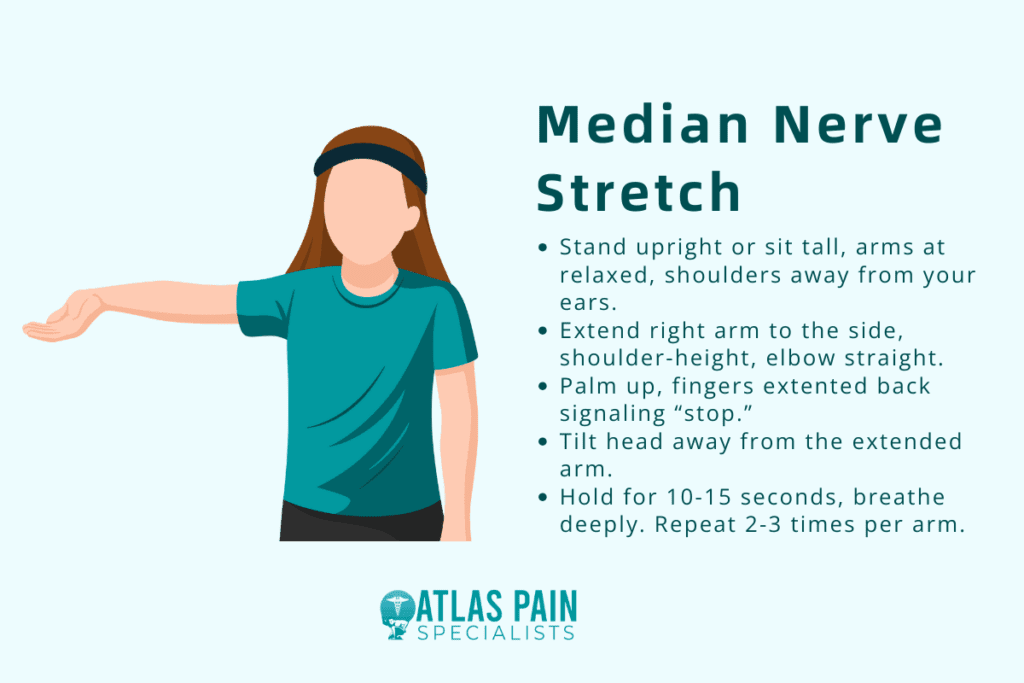
Step-by-Step Stretch (Basic Version)
- Starting Position
Stand upright or sit tall with both arms relaxed at your sides. Keep shoulders away from your ears. - Arm Extension
Slowly extend your right arm straight out to the side at shoulder height. Keep the elbow locked straight. - Wrist and Finger Position
Turn your palm up toward the ceiling, then extend your fingers and wrist backward as if signaling “stop.” You should feel a light pull in your forearm or palm. - Head Movement
For a deeper stretch, tilt your head gently away from the arm. If your right arm is extended, tilt your head toward your left shoulder. - Hold and Breathe
Hold for 10–15 seconds, focusing on slow, steady breaths. Release the tension by returning your arm to your side. - Repeat
Perform two or three repetitions per arm, alternating sides if both are affected.
Advanced Glide Variation
Once you are comfortable with the basic version, nerve gliding can help mobilize the nerve without holding a static position.
- Extend your arm and wrist as described above.
- Slowly bend your elbow, bringing your palm toward your shoulder, while tilting your head toward that same shoulder.
- Straighten the arm back out while tilting your head gently away.
- Repeat 5–10 times, moving in a smooth rhythm.
Nerve gliding focuses on motion rather than holding, making it useful for people with more sensitive symptoms.
Common Mistakes to Avoid
Nerve stretches can feel deceptively simple, which is why they are easy to overdo. The most common mistake is treating nerves like muscles, pushing hard or holding too long, which aggravates symptoms rather than easing them.
Another mistake is ignoring posture. Slouching while stretching limits space in the shoulder and neck, creating more compression on the nerve. The result is frustration rather than relief.
People also tend to rush. Doing one quick stretch and expecting long-term results is unrealistic. Just like brushing teeth, nerve care works best with small, daily habits.
Breathing is another overlooked element. Holding your breath tenses muscles and stiffens the chest, which reduces relaxation. Exhaling slowly as you stretch tells your nervous system it is safe to release tension.
Finally, ignoring warning signs is risky. Persistent numbness, spreading pain, or dropping objects due to weakness are signs to stop and seek professional care. Red flags should never be pushed through, no matter how committed you are to stretching.
When to Seek Professional Guidance
Not everyone should begin nerve stretches without guidance. If your symptoms are severe, persistent, or disrupting daily life, it is time to consult a physical therapist, occupational therapist, or physician.
Carpal tunnel syndrome, for example, often requires wrist splints, ergonomic changes, or medical evaluation. Cervical disc herniations may irritate the median nerve near the spine, making wrist-focused stretches less effective. A professional can identify whether your issue comes from the wrist, elbow, shoulder, or neck, and design a treatment plan that combines stretches with strengthening, ergonomic advice, and sometimes medical interventions.
In a therapy setting, median nerve stretches are often paired with exercises for grip strength, shoulder stability, and posture. This combination reduces the chance of recurrence. Professional guidance also helps you progress safely, increasing intensity only when your body is ready.
Integrating the Stretch Into Daily Life
Consistency matters more than intensity when it comes to nerve health. The best way to benefit from median nerve stretches is to weave them into your daily routine as short, mindful breaks.
If you work at a desk, set a reminder every two hours to stand, stretch your arms, and perform a few glides. Those in trades like carpentry or electrical work can use the stretch as a recovery exercise at lunch or after long periods of gripping tools.
Pairing the stretch with existing habits makes it easier to remember. Doing it after brushing your teeth, while waiting for your coffee to brew, or before climbing into bed builds automatic consistency.
Lifestyle adjustments also make a difference. Adjust your workstation so your wrists remain neutral while typing. Take breaks to stand and roll your shoulders. Use supportive pillows if you sleep with your wrists bent. These small changes support the benefits of stretching.
Supportive Practices
- Strengthening exercises: Build wrist and forearm strength with light resistance bands. Strong muscles support freer nerve movement.
- Postural awareness: Regularly check your sitting and standing posture. Poor alignment at the neck and shoulders creates unnecessary compression.
- Mindful breaks: Every 30–45 minutes, pause and move your hands, wrists, and shoulders. Preventing stiffness reduces nerve irritation.
Table: Stretching vs Gliding for Median Nerve
| Aspect | Static Stretch | Nerve Glide |
| Technique | Hold position for 10–15 seconds | Gentle repeated back-and-forth motion |
| Sensation | Light pull or tingling | Smooth sliding with less intensity |
| Best for | Mild stiffness or tightness | Irritation, sensitivity, or rehab |
| Frequency | 2–3 times per session, daily | 5–10 reps, 1–2 times per day |
| Risk | Higher if overdone | Lower when performed slowly |
Both methods have value, but gliding is often better for sensitive nerves, while static stretching can help when stiffness is the main issue.
Five Things You Didn’t Know About Nerve Burning for Back Pain
Living with back pain often leads people to explore treatments they may have never considered before, and nerve burning is one of those approaches that can sound surprising at first. By learning more about how it works, how long it lasts, who it helps, and what the risks are, you can approach the decision with clarity rather than confusion.
The more you understand about nerve burning, the better prepared you are to talk with your doctor and decide if it fits into your plan for managing back pain. It may not be the right path for everyone, but for those who find relief, it can open the door to moving more freely and enjoying daily life with less discomfort.
Recurring daily headaches can feel like an invisible burden that interrupts focus, drains energy, and disrupts normal routines. Many people experiencing this issue begin to wonder if their symptoms point to something more than just stress or lack of rest.
Daily headaches often stem from a complex mix of physical, environmental, and lifestyle factors that are not always obvious at first. Because the brain and nervous system interact with so many systems in the body, pinpointing the root cause requires attention to subtle details.
Why Do I keep getting headaches every day? Seeking answers often leads people to explore potential connections between posture, sleep habits, nutrition, hydration, and even vision strain. Identifying patterns behind these triggers is the first step toward both short-term relief and long-term prevention.
Common Causes of Daily Headaches
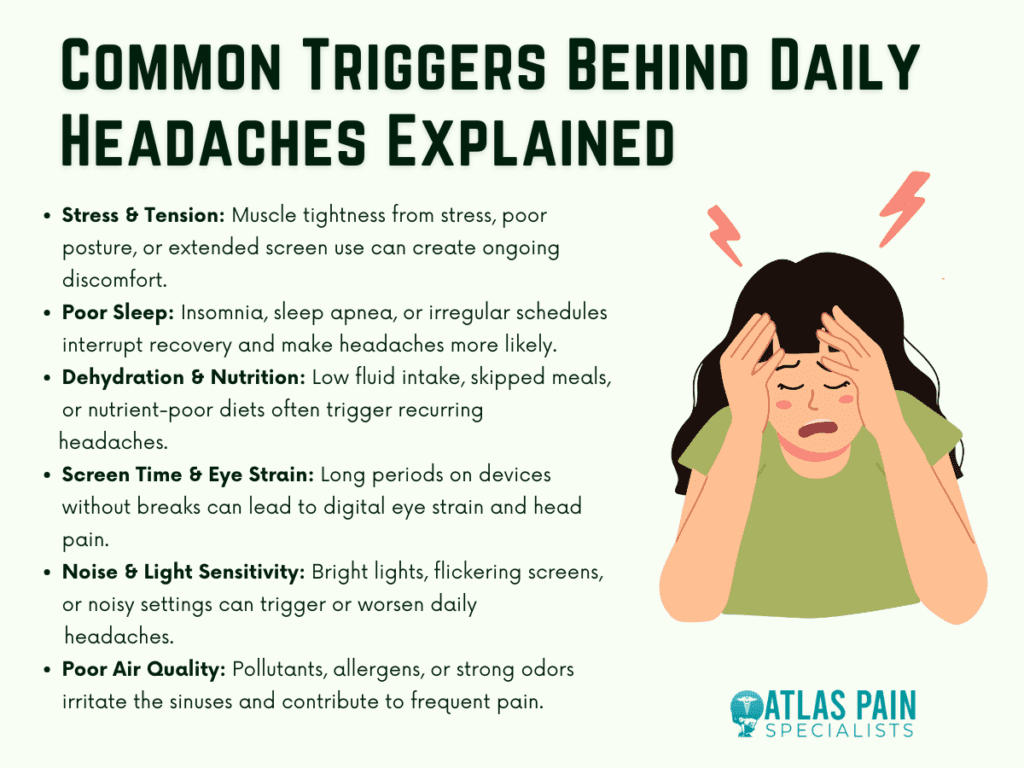
Headaches that appear every day can be influenced by several overlapping conditions that may require lifestyle adjustments or medical attention. A thorough review of daily habits often reveals small factors that add up to persistent discomfort.
This section examines the most common contributors to daily headaches and highlights how recognizing them can guide effective solutions. Each factor interacts differently with the body, which is why identifying your specific trigger is essential.
Tension and Stress
Tension headaches often develop when stress causes muscles in the neck, scalp, or shoulders to tighten. The resulting pressure creates a dull, persistent ache that usually worsens with prolonged periods of mental strain.
Emotional stress is not the only trigger, as physical stress from poor posture or extended computer use can create the same response. This type of headache can last for hours and may return repeatedly if the underlying cause is not addressed.
Simple relaxation techniques, regular stretching, and mindfulness practices can help reduce tension headaches over time. However, in cases where stress levels remain high, professional counseling or stress management programs may be beneficial.
Lack of Quality Sleep
Insufficient or poor-quality sleep significantly increases the likelihood of waking with a headache. Disrupted sleep cycles interfere with the body’s ability to regulate pain sensitivity and repair itself overnight.
Sleep apnea, insomnia, and irregular sleep schedules are common conditions linked to frequent headaches. People who frequently wake feeling unrested often find that their headaches intensify during the day.
Improving sleep hygiene, such as maintaining a consistent bedtime, limiting caffeine intake, and creating a calm sleep environment, often reduces headache frequency. If sleep issues persist, medical evaluation can help uncover hidden sleep disorders that may be contributing.
Dehydration and Nutrition
Headaches frequently occur when the body does not receive enough fluids or essential nutrients. Even mild dehydration can cause blood vessels in the brain to contract, triggering discomfort.
Skipping meals or consuming a diet high in processed foods and low in whole nutrients can also lead to headaches. For example, low blood sugar is a common reason people experience sudden pain or fatigue.
Increasing daily water intake and eating balanced meals rich in proteins, healthy fats, and complex carbohydrates can prevent these episodes. Identifying and avoiding personal dietary triggers, such as excess caffeine or alcohol, can further reduce risks.
Environmental and Lifestyle Triggers
Many people underestimate how strongly their environment influences headache frequency. Exposure to sensory triggers like light, noise, or air quality can create conditions for recurring pain.
Lifestyle choices, including work habits and recreational activities, can also play a direct role in daily headaches. Adjusting these factors may bring noticeable relief.
Screen Time and Eye Strain
Prolonged exposure to computer, phone, or television screens can lead to digital eye strain, a frequent cause of headaches. Bright light, glare, and poor posture during screen use intensify discomfort.
Symptoms often include tightness around the eyes, blurred vision, and head pain that worsens throughout the day. People working in office settings or spending extended time on devices are particularly vulnerable.
Regular screen breaks, proper lighting, and ergonomic adjustments can significantly reduce eye strain. In some cases, blue-light filtering lenses may also help lessen visual fatigue.
Noise and Light Sensitivity
Bright or flickering lights, as well as prolonged exposure to loud environments, are powerful headache triggers. For individuals prone to migraines, these environmental stressors can cause immediate pain.
Constant background noise or sudden changes in sound levels can strain the nervous system. Sensitivity varies widely among individuals, but repeated exposure often leads to daily headaches.
Using sunglasses, adjusting indoor lighting, and creating quieter workspaces can lower exposure to these stressors. Noise-canceling headphones and earplugs are useful tools for people working in busy or noisy environments.
Poor Air Quality
Indoor and outdoor air quality both play a significant role in headache frequency. Pollutants, allergens, or strong chemical odors can irritate the sinuses and trigger discomfort.
People in urban areas or workplaces with poor ventilation often report recurring headaches linked to their environment. Seasonal allergies can also contribute, especially during high pollen periods.
Improving indoor air circulation, using air purifiers, and limiting exposure to strong chemical products can reduce this risk. Consulting with an allergist may also help identify and treat specific sensitivities.
Medical Conditions Linked to Daily Headaches
In some cases, daily headaches may signal an underlying medical condition that requires diagnosis and treatment. These conditions often involve neurological or vascular changes that intensify pain.
Addressing medical causes typically requires professional evaluation, as self-treatment may overlook serious health concerns. Recognizing symptoms beyond the headache itself can provide important clues.
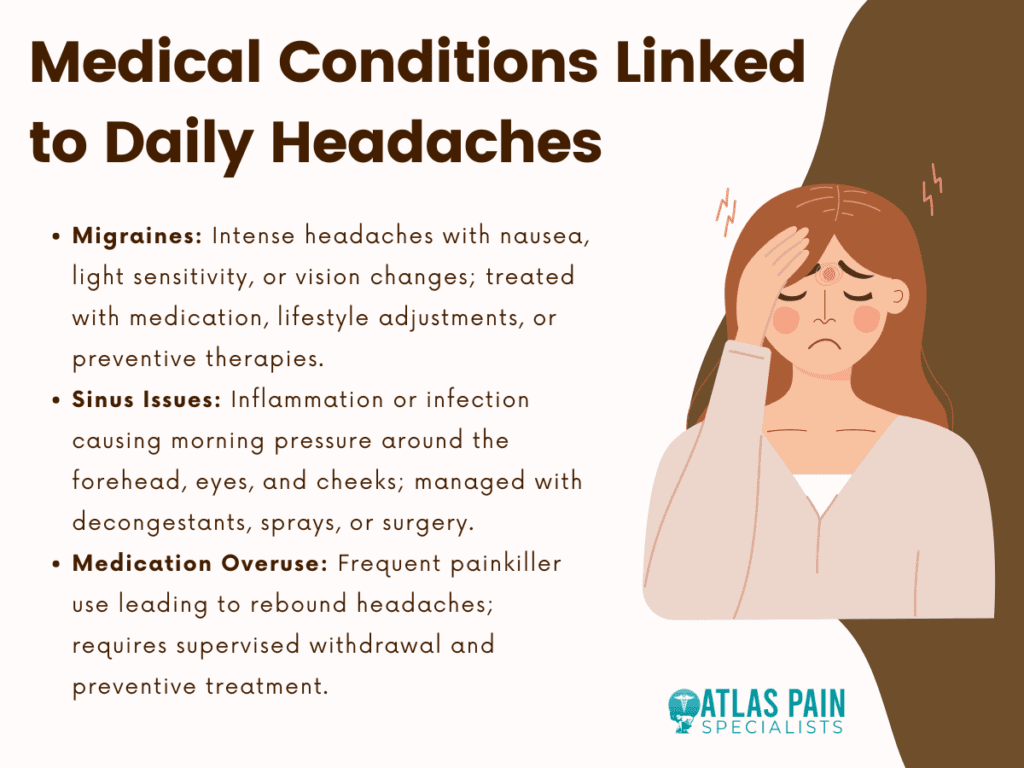
Migraines
Migraines differ from standard headaches due to their intensity, duration, and accompanying symptoms. Many people experience nausea, light sensitivity, or visual disturbances along with severe head pain.
Daily or near-daily migraines can feel overwhelming and are sometimes mistaken for tension headaches. However, their neurological basis requires a different approach to treatment.
Prescription medications, lifestyle changes, and avoiding known triggers often reduce the frequency of migraine attacks. For chronic cases, preventive therapies may be recommended by specialists.
Sinus Issues
Chronic sinus inflammation or infection can cause recurring headaches that often intensify in the morning. Pressure builds around the forehead, eyes, and cheeks, creating a heavy and painful sensation.
Seasonal allergies or structural issues like a deviated septum can worsen these symptoms. People often mistake sinus-related headaches for migraines due to their intensity and location.
Treatments include decongestants, nasal sprays, or surgical correction in severe cases. Addressing the root sinus issue typically reduces the frequency of related headaches.
Medication Overuse Headaches
Ironically, taking pain-relief medication too frequently can lead to rebound headaches. This condition occurs when the body becomes dependent on medication, causing pain to return once it wears off.
Daily use of over-the-counter or prescription headache medications is a common cause of this problem. Over time, the headaches often become more frequent and resistant to standard treatments.
Gradual withdrawal under medical supervision is usually necessary to break the cycle. Physicians may also recommend preventive treatments to help patients transition away from overuse.
Preventive Strategies and Long-Term Management
Preventing daily headaches often requires a blend of lifestyle adjustments, medical care, and self-awareness. Identifying triggers and creating a consistent health routine form the foundation of long-term management.
Adopting practical habits can reduce headache frequency and improve overall well-being. Over time, these small changes contribute to significant improvements in quality of life.
Maintaining Proper Hydration and Nutrition
Consistent hydration supports healthy brain function and helps prevent vascular constriction linked to headaches. Many people underestimate the importance of steady water intake throughout the day.
Balanced meals provide stable blood sugar levels, which reduces the risk of fatigue-related pain. Nutrient-rich diets also strengthen the body’s resilience against stress and inflammation.
Keeping a food and hydration journal can reveal patterns behind recurring headaches. Adjustments to eating habits often produce noticeable results within weeks.
Incorporating Physical Activity
Regular physical activity improves circulation, reduces stress, and strengthens muscles that support the spine and neck. These effects combine to decrease the frequency of headaches.
Activities such as yoga, swimming, or brisk walking offer both relaxation and physical conditioning. Gentle stretching also relieves tension in areas commonly associated with headaches.
Even short daily sessions can provide lasting benefits when practiced consistently. Choosing enjoyable forms of exercise ensures long-term adherence.
Seeking Professional Guidance
When headaches persist despite lifestyle improvements, professional evaluation becomes essential. Neurologists, primary care physicians, and sleep specialists all provide valuable insights into chronic conditions.
Diagnostic tools like imaging scans, blood tests, and sleep studies can uncover hidden causes. These results guide more effective treatment strategies than trial-and-error approaches.
Collaborating with healthcare professionals ensures that both symptoms and root causes are addressed. This approach often brings lasting relief and prevents future complications.
Head Pain Treatments
Daily headaches can feel overwhelming, but understanding their causes is the first step toward meaningful relief. By identifying patterns in lifestyle, environment, or medical conditions, you can begin to take control of your symptoms and reduce their impact on daily life.Still, lasting solutions often require more than self-care. For those struggling with persistent or severe head pain, professional treatment can make all the difference. We provide targeted therapies tailored to each patient’s needs, offering both immediate relief and long-term management strategies to help restore comfort and improve quality of life.
When patients hear that their doctor is referring them to pain management, it often raises questions and even some concern. Many people are unsure what a pain management specialist does or why such a referral might be necessary.
In reality, this step usually means that your physician wants you to receive more focused care for persistent or complex pain issues. Pain management clinics are designed to address conditions that may not improve with standard treatment and offer advanced therapies.
Pain is not only a physical experience but also one that affects emotional health, work performance, and overall quality of life. Pain management specialists use targeted methods that range from interventional procedures to tailored rehabilitation programs. Why is my doctor sending me to pain management? Let's find out.
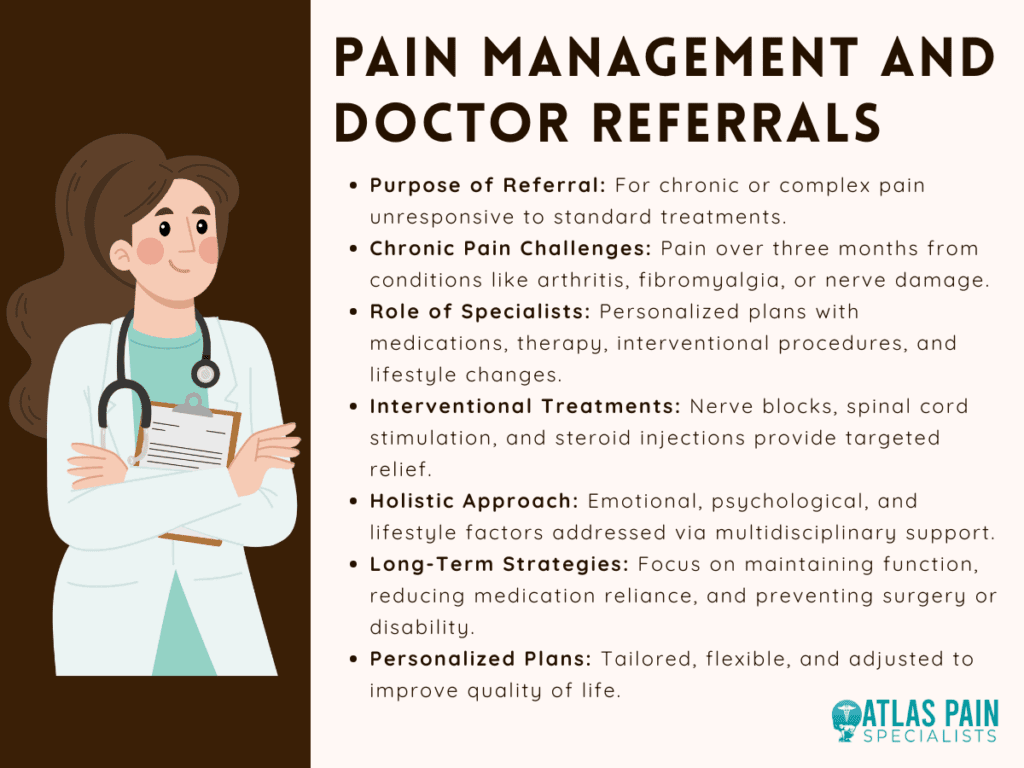
Chronic Pain That’s Not Responding to Standard Treatments
One of the most common reasons your doctor might send you to pain management is if your pain has become chronic and is no longer responding to standard treatments. Chronic pain is defined as pain that lasts for more than three months and persists even after the injury or illness has healed.
It can result from various conditions, including arthritis, fibromyalgia, and nerve damage.
Standard Treatments Often Aren’t Enough
When a person first develops pain, common treatments like rest, over-the-counter pain relievers (acetaminophen, ibuprofen), or physical therapy may help. However, chronic pain can often be stubborn, and these initial treatments may lose their effectiveness over time.
For instance, what worked for you in the beginning may not work as your pain becomes more entrenched.
The Role of Pain Management Specialists
Pain management specialists are trained to approach pain from a multi-faceted perspective. When chronic pain persists despite conventional treatments, a pain management specialist will assess your situation carefully and design a comprehensive treatment plan.
This may include a combination of therapies both medical and non-medical that aim to alleviate the pain and restore function. Since each individual experiences pain differently, your pain management specialist will develop a personalized When patients hear that their doctor is referring them to pain management, it often raises questions and even some concern. Many people are unsure what a pain management specialist does or why such a referral might be necessary. In reality, this step usually means that your physician wants you to receive more focused care for persistent or complex pain issues. Pain management clinics are designed to address conditions that may not improve with standard treatment, offering advanced therapies and a multidisciplinary approach.
Pain is not only a physical experience but also one that affects emotional health, work performance, and overall quality of life. A primary care doctor may treat initial symptoms, but chronic or severe pain requires specialized strategies that go beyond basic prescriptions. Pain management specialists use targeted methods that range from interventional procedures to tailored rehabilitation programs. Being referred to one of these clinics is not a dismissal from your doctor but rather an opportunity to receive comprehensive care that prioritizes your long-term well-being.plan for your unique needs.
Managing Complex Pain Conditions
Pain is not always straightforward. Conditions such as fibromyalgia, neuropathy, and complex regional pain syndrome (CRPS) involve complex pain mechanisms that may not be well understood and can be difficult to treat with traditional methods.
Fibromyalgia and Neuropathy
Fibromyalgia, a condition that causes widespread pain and tenderness throughout the body, often comes with other symptoms such as fatigue, sleep disturbances, and difficulty concentrating.
The pain associated with fibromyalgia is often diffuse and can change in intensity over time, making it difficult to treat. Similarly, neuropathy (nerve damage) causes sensations like tingling, burning, or numbness, often in the hands and feet.
These conditions can be incredibly disruptive and require specialized care.
The Complexity of Complex Regional Pain Syndrome (CRPS)
Complex regional pain syndrome (CRPS) is a condition that typically affects an arm or leg after an injury. The pain is often severe and out of proportion to the original injury and can include swelling, changes in skin color, and sensitivity to touch.
Managing CRPS requires advanced pain management techniques to address the abnormal nerve responses and inflammatory processes involved.
Pain Management for Complex Conditions
A pain management specialist is well-equipped to treat these complex conditions with a variety of methods, such as nerve blocks, spinal cord stimulation, and medications that target the nervous system.
They may also incorporate alternative treatments like acupuncture or biofeedback, which help patients manage pain without relying solely on medication. The goal is not just to relieve pain, but to also improve your overall quality of life and functionality.
Interventional Procedures for Targeted Relief
For some people, pain medications and physical therapy alone are insufficient. This is where interventional pain management comes in. Interventional pain management refers to minimally invasive procedures designed to directly target the source of pain, offering more focused and effective relief than oral medications.
Common Interventional Techniques
Some common interventional procedures include:
- Epidural Steroid Injections: These are used to reduce inflammation around the spinal cord and nerve roots. They’re often recommended for conditions like sciatica, herniated discs, or spinal stenosis. The goal is to provide temporary relief, allowing other treatments (such as physical therapy) to be more effective.
- Nerve Blocks: Involves injecting an anesthetic near a nerve to block pain signals. Nerve blocks are commonly used for conditions like migraines, joint pain, or specific nerve-related pain.
- Spinal Cord Stimulation: This technique involves implanting a small device near the spinal cord to deliver electrical impulses, which can block pain signals and help alleviate chronic pain.
Minimally Invasive and Effective
These interventional techniques are often performed under local anesthesia, and recovery times are relatively short compared to surgery. They allow pain management specialists to treat localized pain without requiring large incisions or long recovery periods.
The goal of these procedures is not necessarily to "cure" the pain but to give you significant, lasting relief that improves your ability to function in your daily life.
A Holistic, Multi-Disciplinary Approach
Pain management is not just about using medication to numb symptoms. In fact, a holistic, multi-disciplinary approach is often one of the most effective ways to manage chronic pain.
This approach recognizes that pain affects the whole person not just the physical body and addresses the emotional, mental, and lifestyle components as well.
The Role of a Multidisciplinary Team
Your pain management specialist will often collaborate with other healthcare professionals, including physical therapists, occupational therapists, psychologists, and sometimes even nutritionists.
For example, physical therapy can help you strengthen muscles and improve mobility, while occupational therapy can teach you techniques to perform daily activities with less discomfort.
Psychological Support
Pain can take a heavy toll on mental and emotional health. Chronic pain often leads to depression, anxiety, and frustration.
Cognitive-behavioral therapy (CBT) is a form of therapy that helps individuals develop coping strategies and change negative thought patterns associated with pain.
Pain management specialists will often recommend CBT or other psychological therapies as part of a comprehensive treatment plan to help you manage the emotional and psychological aspects of chronic pain.
Long-Term Pain Management Strategies
Chronic pain isn’t something that can always be eliminated entirely, especially if it’s linked to a long-term condition like arthritis, fibromyalgia, or nerve damage. For this reason, pain management specialists often focus on developing long-term strategies that aim to reduce pain flare-ups and improve your overall quality of life.
Maintaining Function and Mobility
The ultimate goal of pain management is not just to eliminate pain but to ensure that you can continue functioning and enjoying life despite the pain. A pain management specialist will work with you to create a sustainable plan for reducing pain and improving your mobility. This plan might include a combination of exercises, therapy, lifestyle changes, and medication that will allow you to stay active and independent.
Avoiding Dependency on Medication
Another key goal of long-term pain management is to minimize the risk of dependency on pain medications. Many people with chronic pain rely on medications like opioids to manage their symptoms.
However, these medications can be addictive and have side effects. Pain management specialists focus on using the smallest effective dose of medication and may explore other non-medication options to help you manage pain without over-relying on drugs.
Medication Management and Monitoring
If you’re currently taking pain medications, particularly opioids or other potent painkillers, the management and monitoring of these medications becomes an important part of your care. Pain management specialists are skilled in managing medication use to ensure it remains safe and effective over time.
The Importance of Monitoring Medication Use
Pain management specialists are trained to assess the risks of long-term medication use, particularly when it comes to opioid medications, which carry a risk of dependence and other side effects.
They will closely monitor your progress and adjust your medications as necessary to help you maintain an effective pain management regimen. If opioids are part of your treatment plan, they will help you manage your use in a way that minimizes the risk of addiction or misuse.
Exploring Non-Medication Alternatives
In addition to medication, pain management specialists will often recommend non-pharmaceutical treatments, such as acupuncture, massage therapy, or chiropractic care. These alternative treatments can be effective in reducing pain, and they offer valuable options for people who are looking to avoid or reduce their reliance on medications.
Preventing Surgery and Disability
Pain management specialists aim to help you avoid surgery whenever possible, especially if the pain can be controlled through less invasive means. In some cases, untreated chronic pain can lead to disability or the need for surgery, but pain management specialists work to reduce or prevent these outcomes by offering alternative treatments.
Avoiding Surgical Interventions
In some cases, surgery may be the most effective solution, such as with certain types of spinal issues or joint problems. However, a pain management specialist will help you explore all options first, offering treatments that might reduce pain enough to avoid surgery altogether.
Minimally invasive procedures, physical therapy, or medications may be able to manage your pain without the need for invasive surgery.
Maintaining a High Quality of Life
By providing targeted pain relief and treatment strategies, pain management specialists can help prevent disability, allowing you to continue living independently and participating in daily activities. Their goal is to help you maintain a high quality of life, no matter the challenges your pain condition presents.
Personalized Treatment Plans
Each individual experiences pain differently, and effective pain management relies on a highly personalized approach. When you see a pain management specialist, they will work closely with you to create a treatment plan tailored to your specific condition, needs, and lifestyle.
Individualized Care
Your pain management plan will take into account factors like the type and location of your pain, your personal medical history, and your goals for treatment. Whether it involves medications, physical therapy, psychological therapy, or interventional procedures, your treatment plan will be designed to help you achieve the best possible outcome.
Flexibility and Adjustments
Pain management is a dynamic process, and your specialist will regularly reassess your progress and make adjustments to your treatment plan as needed. As your condition evolves or as new treatments become available, your specialist will ensure that your plan stays relevant and effective.
What to Expect from a Pain Management Doctor
When a doctor refers a patient to pain management, it signifies an important step toward specialized care rather than an inability to help. Pain management clinics provide access to advanced treatments, a range of therapeutic options, and expertise.
These clinics focus on long-term solutions, helping patients reduce discomfort, regain mobility, and improve quality of life. A pain management doctor dedicates time to evaluating the full scope of a patient’s condition, considering medical history, lifestyle, and previous attempts at relief.
Patients can expect a detailed consultation in which the doctor listens carefully to their concerns and explains the different avenues of care. A pain management doctor also provides access to a wide range of therapies that can be combined to form a personalized plan.
Back pain is one of the most common complaints in the United States, affecting millions of adults each year. It disrupts sleep, limits work, and changes how people go about everyday life. While physical therapy, medications, and exercise often help, many people find that these measures only go so far. For those who live with persistent discomfort, a treatment called radiofrequency ablation—often nicknamed “nerve burning” sometimes enters the conversation. The name alone can be enough to spark anxiety, yet the reality of the procedure is different than most imagine. Nerve burning is not a destructive act but a carefully planned therapy designed to reduce pain signals and improve daily function.
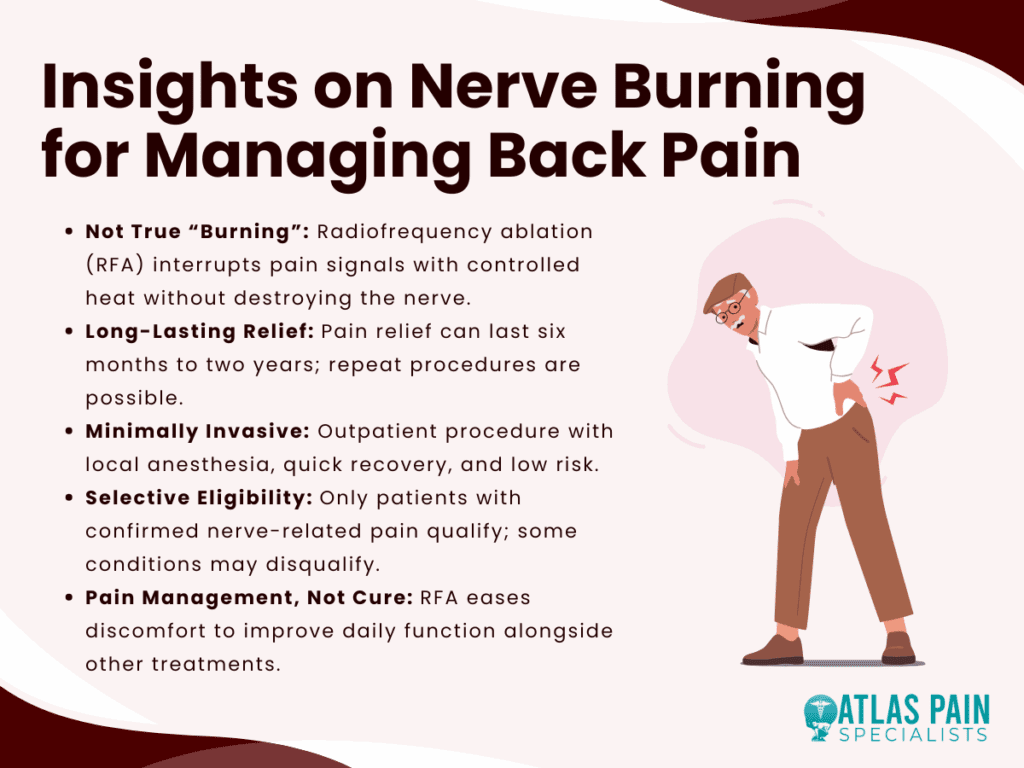
Below are five things most people do not know about this treatment, explained in detail to show where it fits into modern back pain care.
1. It’s Not Actually “Burning” in the Way You Think
The name “nerve burning” paints a dramatic picture, but the truth is far more refined. The medical term for the procedure is radiofrequency ablation, or RFA. During the treatment, a doctor inserts a thin probe through the skin to reach the nerve suspected of carrying pain signals. Imaging technology like fluoroscopy is used to ensure accurate placement. Once in position, radio waves generate heat at the tip of the probe, interrupting the nerve’s ability to transmit pain.
What happens is not the fiery destruction of tissue but a controlled interference in communication between the nerve and the brain. This interference reduces the sensation of pain without eliminating the nerve completely. Over time, the nerve often regenerates, which is why the procedure can be repeated when needed.
Precision Targeting of Nerves
A fascinating detail is the precision behind the therapy. Doctors use test stimulations before applying radiofrequency, ensuring the correct nerves are targeted. This method spares surrounding muscles and tissue from unnecessary damage. Compared with surgery, which physically alters structure-
s of the spine, this targeted approach is gentler, reversible, and far less risky.
A Misunderstood Name
The term “burning” has stuck partly because of the heat involved, but it has led to misunderstandings. Many patients initially fear the idea of scorched nerves, only to be surprised when their physician explains the subtlety of the treatment. Understanding this distinction helps patients approach the procedure with more confidence and less apprehension.
2. Relief Can Last Longer Than You’d Expect
Some people assume nerve burning only offers a short-term reprieve, similar to an injection that wears off quickly. In reality, the results often last far longer. On average, pain relief ranges from six months to two years. This wide window reflects differences in health, age, the underlying condition, and lifestyle habits.
Radiofrequency ablation acts as a middle ground between quick fixes like steroid shots and major steps like surgery. It gives patients time to regain control of their lives without committing to the permanent changes and risks of invasive operations.
Why Relief Varies
The longevity of relief depends on how quickly the nerve regenerates. In some individuals, regrowth may occur sooner, while in others, the benefits last years. Factors such as arthritis severity, physical activity, and weight can also play roles. For example, someone with advanced degenerative disc disease may find that relief lasts closer to the shorter end of the spectrum, while someone with localized facet joint pain may enjoy longer results.
The Value of Repeat Procedures
Another underappreciated advantage is the ability to repeat the procedure. Once a patient responds well the first time, doctors are usually confident about offering another session when pain returns. This creates a cycle of relief that can be maintained over the years, reducing reliance on heavy medications or more invasive treatments.
3. It’s Minimally Invasive with a Quick Recovery
For people already tired of constant pain, the last thing they want is a long hospital stay or a difficult recovery. Radiofrequency ablation avoids this problem entirely. The procedure is performed in an outpatient setting and usually takes less than an hour. Patients receive local anesthesia and sometimes mild sedation but rarely require general anesthesia.
Recovery is quick, with most people returning to their usual activities within a few days. Some even go back to work the next day, depending on their comfort level. This ease surprises many who expected weeks of downtime.
Comparing Recovery with Surgery
When compared with spinal surgery, the difference is stark. Back operations often require weeks or months of rehabilitation, with risks such as infection, scarring, or long-term stiffness. By contrast, RFA leaves only a small puncture at the site of needle insertion. Discomfort afterward is usually mild soreness, which resolves quickly.
Risks and Safety Considerations
Every medical procedure carries risks, but RFA’s are relatively low. Infection and bleeding are rare, and serious complications like permanent nerve damage are uncommon. Most patients find the risks acceptable given the potential rewards, especially when compared with the side effects of long-term pain medications.
4. Not Everyone Qualifies for the Procedure
Despite its benefits, nerve burning is not offered to every patient with back pain. Physicians must first confirm that the pain originates from the nerves RFA is designed to target. To do this, they use a test called a diagnostic nerve block. A small amount of anesthetic is injected near the suspected nerve. If pain decreases significantly for the duration of the anesthetic’s effect, it suggests that RFA would be helpful.
This step ensures that only patients with nerve-related pain undergo the procedure, improving success rates and preventing unnecessary interventions.
Who May Not Qualify
Certain groups may not be good candidates. People with bleeding disorders or active infections are usually advised against the procedure. Those with pacemakers or other implantable devices may need special precautions. Additionally, patients whose pain stems mainly from muscle strain, herniated discs, or systemic illness may not benefit.
The Importance of Specialist Evaluation
Because back pain can have many sources, a thorough evaluation is vital. Pain specialists, interventional radiologists, or anesthesiologists trained in this therapy are best equipped to determine eligibility. Their expertise helps ensure that the right patients receive the right treatment.
5. It Doesn’t Cure Back Pain but Manages It Effectively
One of the biggest misconceptions about nerve burning is that it offers a permanent cure. While the relief can be dramatic, it does not stop the underlying condition that caused the pain in the first place. Arthritis, disc degeneration, and spinal stenosis remain even after nerves are quieted.
What RFA does is buy patients the freedom to live more comfortably while addressing their condition through other means. This makes it a powerful tool in a comprehensive plan rather than a standalone solution.
Combining RFA with Other Therapies
For many patients, the procedure creates an opportunity to re-engage in physical therapy or exercise programs that were impossible when pain was overwhelming. Improved movement allows for muscle strengthening, weight management, and healthier posture. These changes support long-term back health and can extend the benefits of the procedure.
Quality of Life Matters
Even when pain eventually returns, many people report that the months or years of relief transformed their lives. Being able to sleep without constant discomfort, walk without frequent stops, or work with fewer limitations are meaningful improvements that restore independence and well-being. In this sense, the measure of success is not a cure but a life lived more fully.
Comparing Nerve Burning to Other Back Pain Treatments
When looking at the landscape of back pain treatment, it becomes clear where radiofrequency ablation fits. It is more effective and longer-lasting than steroid injections, less invasive than surgery, and more immediate than physical therapy.
| Treatment | Invasiveness | Recovery Time | Duration of Relief | Ideal Use |
| Radiofrequency Ablation | Minimally invasive | A few days | 6 months to 2 years | Chronic nerve-related pain |
| Steroid Injections | Minimally invasive | 1–2 days | Weeks to months | Pain linked to inflammation |
| Physical Therapy | Non-invasive | Ongoing | Long-term with consistency | Mobility and strength building |
| Surgery | Highly invasive | Weeks to months | Potentially permanent but higher risks | Severe structural conditions |
| Medications | Non-invasive | None | Hours to days | Temporary symptom relief |
The table highlights how nerve burning balances effectiveness with safety. It does not replace other therapies but holds a distinct place as a middle-ground option for patients who need more than conservative care but want to avoid the risks of surgery.
Conclusion
Chronic back pain affects far more than the spine; it reshapes daily routines, limits independence, and erodes quality of life. Radiofrequency ablation, often misunderstood as a destructive treatment, offers a safe and precise way to reduce pain without major surgery. By quieting pain signals, it gives patients the breathing room to rebuild strength, reclaim mobility, and enjoy meaningful relief that lasts months or even years.
Although not everyone qualifies and it is not a cure, nerve burning stands as an important option within the spectrum of back pain management. Understanding its true nature helps patients and families make informed choices, moving from fear of the term “burning” to appreciation of its role in improving lives.
